] 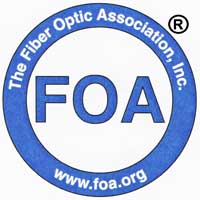

February 2023
|
Search the FOA website
FOA Home Page
Contact
Us
|
Sign
up for the FOA eMail Newsletter
Privacy Policy
Sections
News
Technical
Worth
Reading Q&A
Training/FiberU
Resoures
Safety
About
|
February Is Tech Month
Using OTDRs To Test Transoceanic Cables
OTDR Testing PONs
Upgrading GPON To 10G
Upgrade Problems With Older Fibers
DIY FTTH - LCS FiberCom
BI Fiber Identification
FOA Converting To Online Credentials
Latest FOA Book - Fiber Broadband
New Fiber U MiniCourse - Project Management
Fiber Optic Conference For Latin America
More Translations Of FOA Textbooks
Newsletter Sections
Click
on any link to jump to that section
News
TIA BEAD Success Summit
Help For OJT Programs
Art Contest Promotes Digital Inclusion
Fiber Optic Design For Metro/Traffic Engineers
AT&T/BlackRock Gigapower Joint Venture
Technical
Micro Cables Get Smaller
Fake OTDR Traces
Managing Projects - Gantt Charts
FOA Color Code Guides
FOA Online Loss Budget Calculator
Worth
Reading Lots of interesting
articles
Q&A
Questions from our readers
Always Interesting!
Training/FiberU
New FOA-Approved Schools,
Fiber U
MiniCourses
more
Resources
New FOA Technical Resources
Safety
About the FOA
FOA Certified Techs:
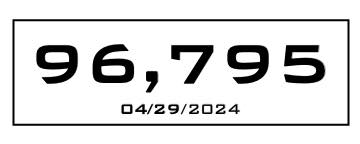
Time
To Renew Your FOA Certifications?
Special offer - 1/3
Off Renewal
Jobs
- See FOA Jobs
Web Page and FOA on

- The FOA Jobs
Web Page has been updated and a new page added
on Using your FOA
Training/Certification to Find the Right Job
in Fiber Optics
Where
Are The Jobs In Fiber Optics? FOA talks about
all the applications for fiber optics, what jobs
involve and the qualifications for the workers in
the field in this YouTube video.
Join The FOA eMail Newsletter
List
Want
to be notified when the FOA Newsletter is updated? Sign
up for the FOA eMail Newsletter. You can
also sign up from your cell phone: text "FOA" to
22828 (usual text message charges apply)
Trademarks:
The FOA CFOT® (Certified Fiber Optic Technician) and
Fiber U® (the FOA online learning site) are
registered trademarks of the FOA.

Want to know more about fiber optics?
Looking for specific information? Here's the largest
technical reference on the web: The
FOA Online Fiber Optic Reference Guide.
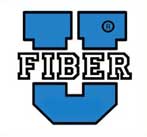
Free online self-study programs
on many fiber optics and cabling topics are
available at Fiber U,
FOA's online web-based training website.
FOA
Reference Books
Available Printed or eBooks
The fiber book is
available in Spanish and French
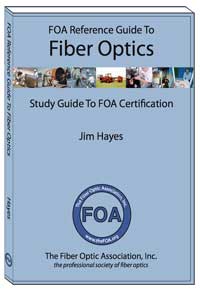 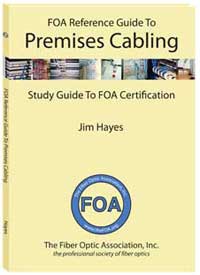 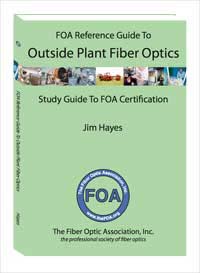
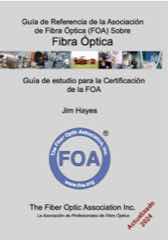
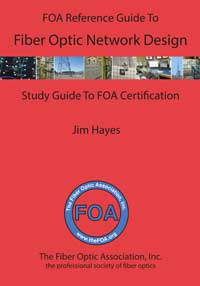 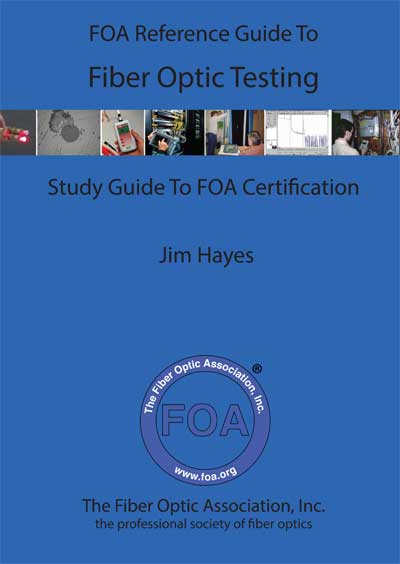
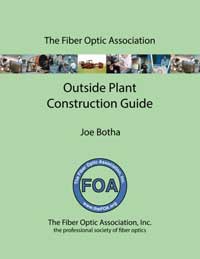 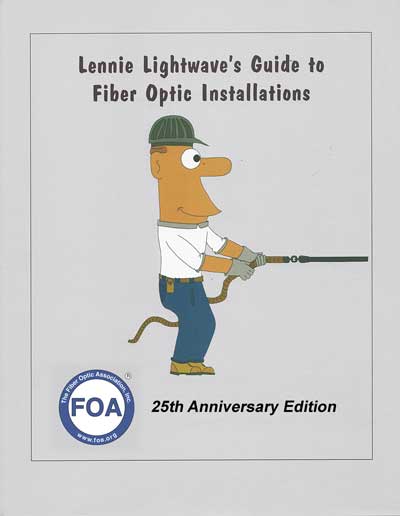
Lennie
and Uncle Ted's
Guides are now also available as free iBooks on
iTunes.
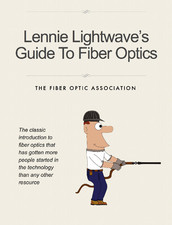
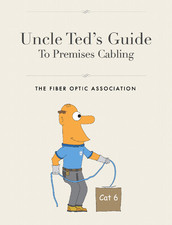
Click on any of
the books to learn more.
- Fiber
Optic Safety Poster to download and
print
FOA Videos on 
FOA
is a member of:




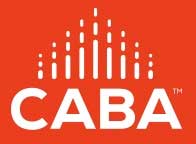
The FOA Newsletter is
edited by Jim Hayes - send your stories, leads,
ideas, comments to <jim @ foa.org>

Search the FOA Website With
DuckDuckGo
Top Stories From The Past FOA Newsletters
- The Archives: Past
Issues.
- Use these links to
read past issues or use FOA's
Custom Search to look for specific
topics on our website.
1/23, 2/23,
1/22, 2/22, 3/22, 4/22, 5/22, 6/22, 7/22, 8/22, 9/22, 10/22, 11/22, 12/22
1/21, 2/21. 3/21, 4/21, 5/21, 6/21, 7/21, 8/21, 9/21, 10/21,
11-12/21,
1/20,
2/20,
3/20.
4/20,
5/20,
6/20,
7/20,
8/20,
9/20,
10/20,
11/20,
12/20,
1/19,
2/19,
3/19,
4/19, 5/19, 6/19, 7/19, 8/19, 9/19,
10/19,
11/19,
12/19
1/18,
2/18,
3/18, 4/18,
5/18, 6/18, 7/18, 8/18, 9/18, 10/18,
12/18.
1/17, 2/17, 3/17, 4/17, 5/17, 6/17,
7/17,
8/17,
9/17,
10/17, 11/17,
12/17
1/16, 2/16, 3/16,
4/16,
5/16,
6/16,
7-8/16,
9/16,
10/16,
11/16,
12/16
1/15,
2/15,
3/15,
4/15,
5/15,
6/15,
7/15,
8/15,
9/15 ,
10/15,
11/15
, 12/15
1/14,
2/14,
3/14,
4/14,
5/14,
6/14,
7/14,
8/14,
9/14,
10/14,
11/14,
12/14
1/13,
2/13,
3/13,
4/13,
5/13, 6/13,
7/13,
8/13,
9/13,
10/13,
11/13,
12/13
1/12
, 2/12,
3/12,
4/12,
6/12,
7/12,
8/12,
9/12,
10/12,
11/12,
12/12
1/11 ,
2/11,
3/11,
4/11,
6/11,
7/11,
8/11,
9/11, 10/11,
11/11,
12/11,
1/10 ,
2/10,
3/10,
4/10,
05/10,
07/10,
08/10,
09/10,
10/10,
11/10
1/09 ,
2/09,
3/09,
04/09,
05/09,
07/09,
08/09,
09/09,
10/09, 11/09,
12/09
1/08 , 2/08, 3/08, 4/08, 5/08, 6/08, 7/08, 8/08, 09/08, 10/08, 11/08, 12/08
12/07 , 11/07, 10/07, 09/07, 08/07, 07/07, 06/07, 05/07, 04/07, 03/07, 2/07, 1/07
12/06 , 11/06, 10/06, 09/06, 8/06, 7/06, 6/06, 5/06, 4/06, 3/06, 2/06, 1/06,
12/05 ,11/05, 10/05, 09/05, 08/05, 07/05, 6/05, 5/05, 4/05, 2/05, 01/05,
12/04 , 10/04, 9/04, 8/04, 7/04, 6/04, 5/04, 4/04, 3/04, 1/04,
12/03 , 11/03 10/03 9/03, 8/03, 7/03, 6/03, 3/03, 10/02 , 8/02, 5/02
Current Issue of FOA
Newsletter
Highlights from the FOA Newsletter in 2022
Multiple bullets hit Xfinity fiber cable, causing outage in Oakland (February 22)
More Thoughts On Broadband For Rural Areas (March 22) (June 22)
Fiber Optics In The Movies - Star Wars Special Effects (March 22)
Fiber Optics Again Helps Find A Famous Shipwreck (April 22)
Thinking About A Fiber Optic Project? Better Get Started Soon (April 22)
AT&T Says Good-bye To Copper (April 22)
More Pole Stories And Photos (May 22)
Why Stop At Gigabits? Let's Design Fiber Networks For Terabits (July 22)
Understanding The Fiber Optic Workforce (August 22)
Does the Infrastructure Investment and Jobs Act (IIJA) truly benefit people in rural America? (September 22)
Can Wireless Compete With Fiber? Satellites? (October 22)
What is Certification/How Do you Learn (November 22)
School Special Issue (with photos) (December 22)
New Fiber U Self Study Programs
Fiber Characterization (for long distance, high speed networks)
Minicourses: Attenuators, Reference Cables, Project Management
December 2022 Special Feature: A Salute To FOA's Schools And Training Organizations
Time To Renew Your
FOA Certifications?
To
keep your FOA certifications active, you need to
renew them when they expire. Now we have a new more
convenient way to renew - an online store at Paypal
- where you can quickly and conveniently use your
PayPal account or your credit card to renew your
certifications.
- You can now renew
with a credit card or PayPal
-
Join FOA On
Social Media

FOA
has 3 LinkedIn Groups
FOA
- official page on LinkedIn - covers FOA, technology and jobs in the fiber optic
marketplace
FOA
Fiber Optic Training - open to all, covers
fiber optic technology and training topics
Grupo
de La Asociación de Fibra Óptica FOA (Español)
|
February Is Tech Month
The FOA Newsletter has recently been focused on
applications, especially FTTH, so we thought for a change of pace, we'd
devote out features section this month to technology. Much of the
technology being developed in fiber optics seems quite like science
fiction, but some isn't and some of those sci-fi ideas become reality.
For example, no development has had a bigger impact on long-haul high
speed networks than coherent transmission, but a paper at the coming OFC
conference says that the complex digital signal processing of current
systems can be simplified into less complex, lower power analog
circuits. Coherent technolgoy has also found a place in shorter high
speed links and even test instrument as you can read below.
Simpler solutions are not being overlooked. Cables like the 864 fiber Prysmian design below
depends on fibers with smaller 200 micron diameter coatings instead of
the traditional 250 microns. But that design still uses 125 micron OD
fiber. Talk of fiber with a glass diameter of 100 microns and coatings
of 130-140 microns indicates a likelihood that we will see even smaller
microcables soon.
Here are some technology based articles we think you will find interesting.
FOA gets some really interesting
questions from our readers that help us keep track with new technology.
This month, a reader asked us for more technical information on C-OTDRs.
Our first response was "what's that?" Then we did some research and
will share that with you, our readers.
How To Use An OTDR to Test A Transoceanic Cable
The world is now connected with over 400 transoceanic
cables carrying unimaginable amounts of data. The world depends on
these cables for communications, so testing and, in case of a problem,
troubleshooting them quickly.
On land, we use OTDRs, but we have access to most cables at many
locations where drops are connected. But a transoceanic cable may have
only access at each end of a cable thousands of km long, complicated by a
number of repeaters consisting of fiber amplifiers.
That creates two problems for using OTDRs, first the long distances
involved and secondly the fact that fiber amplifiers are unidirectional -
they cannot pass the backscatter signal the OTDR used to create traces
and analyze the fiber.
A reader of this newsletter gave us the clue to understand the solution
to this problem by asking us "What is a C-OTDR?" A C-OTDR is a coherent
OTDR. If you remember we explained coherent transmission here in the
Newsletter before and created a page on coherent transmission systems in the FOA Guide.
A coherent OTDR uses the same tech as a coherent link, with a
transmitter that uses an external modulator to create pulses and a local
oscillator in the receiver to increase dynamic range. In the OTDR, the
local oscillator is simpler to provide, just tap the test source
transmitter laser, since the transmitter and receiver are in the same
instrument.
But how do you overcome the problem of blocking of the backscatter signal by the inline optical amplifiers? Take a look at this diagram from Anritsu, the manifacturer of a C-OTDR.
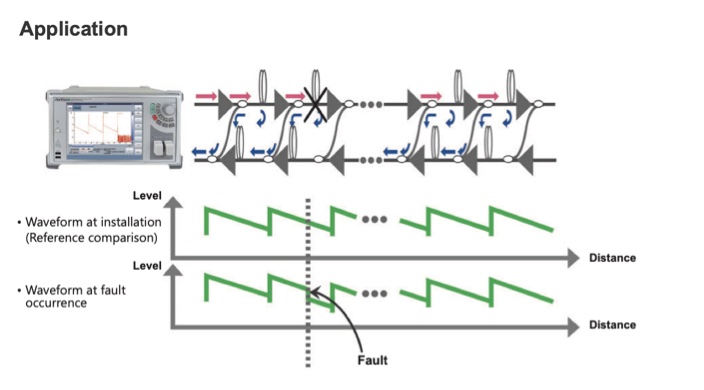
Note two things - the OTDR does not have one port like a regular OTDR,
it has two - transmit and receive. Secondly, the test is made with two
fibers which normally transmit in opposite directions. The test signal
is transmitted through and amplified by each fiber amplifier. But the
output of the amplifier is split and a fraction of the signal is sent to
the fiber transmitting in the opposite direction to return the test
signal to the OTDR. The trace created is a series of link test for each
span between the amplifiers.
A technical paper by Huawei engineers on coherent OTDRs shows a slightly different approach.
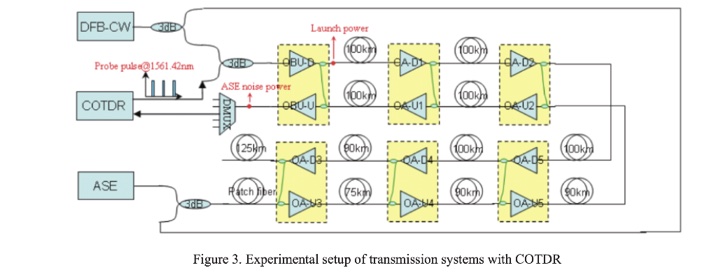
The Huawei solution couples the signal out of the fiber amplifier to the
input of the fiber amplifier next to it, amplifying the return signal.
It appears that both approaches work.
The OTDR traces essentially show a series of traces for each link in a
row, allowing the tech doing the testing to characterize the links when
installed and to pinpoint problems when necessary.
OTDR Testing FTTH PONs
A reader sent us a question about problems they were having testing PONs
with OTDRs. Normally OTDRs are used on FTTH PONs from the subscriber
upstream because of the confusing trace looking downstream. But this
reader brings up another problem.
Q: I wonder if you can help me with a network I’m working on. It’s
got multiple cascading splitters in each network cable plant and I’m
not sure how to calculate it. My team used the light from the OLT
sourcess to test to the customer and the readings were well within spec
with the PM LS.
OTDR is another issue- we had a hard time testing from customer to the
SFP because of the high loss. We found increasing the pulse to 1us gave
us some line of sight but not a usable trace. I believe the issue
is total loss. Our engineering group Mia calculated the budget -
splitters are 1:4 every fosc and then cascade to 1-3 splitters in
addition the 1:4 and range from 1:4 / 1:8/ 1:32.
Any advice or direction would be most appreciated.
A: If this is GPON the working loss range at the subscriber should be
~13 to 28 dB for a 32 split.
https://foa.org/tech/ref/appln/FTTH-PON.html There are other versions
with more dynamic range too.
If you are doing a FTTH loss budget,
1X4 splitters should have about 7 dB loss, 1X2 a bit less than 4 dB
loss. A total split of 32 should be ~ 18 dB for splitters plus all fiber, splice and connector losses.
Testing with an OTDR should be done upstream from individual subscribers
and the OTDR needs to be expecting ~ 18 dB plus fiber to as much as the
28 dB loss limit, so that’s equivalent to nearly 50km of just fiber.
You will need a fairly long test pulse to get that dynamic range or a
lot of averages. With that long a pulse, you are going to have
some resolution problems on typical short FTTH PON networks.
Testing PONs requires an OTDR with what seem like conflicting specs -
high dynamic range and high resolution. Most OTDR manufacturers offer
specific instruments for this application.
The problems with testing a PON network, especially a cascaded one, with
an OTDR is the losses at the splitter create conundrum for OTDR setup -
if you set up the OTDR for range, generally increasing the pulse width
as you would for a long cable with high loss, you lose the resolution
you need for the short PON network. A better alternative is increasing
the number of averages, which adds time for testing.
Perhaps a better solution is to use a design that adds test points with
connectors around all the splitters to allow testing the link segments
between splitters individually.
Network speeds must
continually increase to accommodate more users and faster applications.
The people developing GPON technology and standards have taken a very
intelligent approach to network updates. One of our readers sent us this
explanation.
Upgrading GPON TO 10G
Vladimir Grozdanovic
The architecture of a PON system consists of three segments. The OLT
(Optical Line Terminal) is the main element of the system that enables
the connection of ONUs (Optical Network Units at the subscriber)
to MAN/WAN networks. The next segment is ODN (Optical Distribution
Network - the cable plant). This is the biggest and the most expensive
element of this system. The final segment is ONU. The task of the ODN is to connect the ONUs (Optical Network Unit) to the OLT.
There are different FTTx PON scenarios: FTTC (w/DSL), FTTB,
FTTH, etc. It depends on the ONU location. FTTH GPON is the most
widespread technology, however, due to the great demands of subscribers,
Today the migration from GPON to XG(S)-PON FTTH is underway or nearing
completion.
GPON enables a max 2.5Gbps/1.25 Gbps per PON port. These are enough data
rates for most residential users. However, services such as online
gaming, AR/VR, telemedicine, 3D web scenes, holo chat applications, 4K
and 8K video, free viewpoint, etc. require higher data rates in both
directions. In addition, business users have significantly higher
requirements than residential users. That is why the migration from GPON
to XGPON or XGS-PON started. XG(S)-PON enables higher data rates and
lower latency compared to GPON. Max data rates per PON port is 10/2.5
Gbps (XG-PON) or 10/10 Gbps (XGS-PON).
Telecommunications operators want an easy and safe migration to the new
PON standard. They want to save the most expensive part of the system -
the cable plant, ODN. GPON and XG(S)-PON use different wavelengths, which enables the coexistence of two PON standards in the same ODN. GPON uses 1490 nm for downstream and 1310 nm for upstream, and XG(S)-PON uses 1577 nm for downstream and 1270 nm for upstream.

Modern OLTs generally support GPON and XG(S)-PON boards. Because of
that, migration from GPON to XG(S)-PON can be realized using XG(S)-PON
service boards (hybrid solution) or combo/flex PON service boards.
A hybrid solution is a solution where GPON and XG(S)-PON service boards
are combined in the same OLT or in two or more independent OLTs. The
parallel operation of two PON standards in the same ODN is enabled by
using the WDM module (mux/demux). In this way, subscribers can use GPON
or XG(S)-PON.
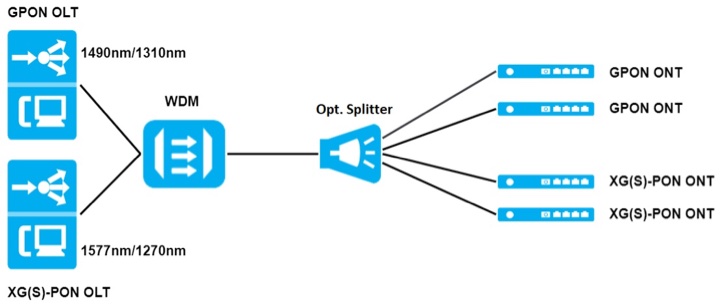
This solution maintains the existing GPON boards, however, this solution
also introduces new component - WDM mux/demux. These WDM modules
require reorganization in headends (HE) or central offices (CO). In
addition, WDM modules increase IL (Insertion Loss) by about 1 to 1.5 dB.
Sometimes updating the OLT software or replacing the control boards is
required.
The second and last solution is the solution with combo or flex PON
boards with both GPON and 10GPON on the board with one port. These boards are installed in the existing OLT. This means that
the existing GPON service boards are uninstalled. Combo or flex boards
have slots for SFP optical modules that combine GPON and XG(S)-PON, and
have built-in WDM mux/demux.
Vladimir Grozdanovic is a graduate electrical engineer for
telecommunications with more than 10 years of experience in access
networks (HFC and FTTH) in large cable operators in Serbia (SBB and
Jotel).
Read more on 10GPON upgrades in the FOA Guide.
Upgrades To Network Speeds May Have Problems On Older Fibers
Practically every network operator wants to
upgrade speeds because it's cheaper than installing more fiber. But
sometimes it causes problems, and even worse if it involves mixing fiber
types. Here is another conversation we had this month with FOA Master
Instructor Joe Botha of Triple Play Fiber Optics in South Africa.
FOA: We have a question on one of the FOA’s social media sites
about problems with fusion spliced G.652 and G.657 fiber. Supposedly the
loss of the cable plant is good but they are having problems with 40G
transmission. Does that make sense? The work you did and we published in the FOA Guide about splicing dissimilar fibers said the losses were not a problem. But have you heard any problems with higher speed data?
Joe B: The very same problem is experienced locally, where
network providers are struggling with their 40G to 200G transmission,
and it has nothing to do with attenuation. Put simply, they are using
the wrong fiber, G.652D and G.657.A2 instead of G.655 or G.656 fiber.
The dispersion coefficient for G.652D and G.657.A2 is too high and at
40G, you are unlikely to go much further than 4km, without running
errors. It varies from 16.9 to 18.2 ps/nm.km at 1550 nm. It is worth
noting that for G.655 and G.656 fiber, it varies from as low as 2.6 to
6.0 ps/nm.km at 1550 nm.
New sophisticated modulation techniques such as dual-polarized
quadrature phase-shift keying (DP-QPSK) using coherent detection, yields
high quality CD compensation. However, because of the added signal
processing time (versus simple on-off keying) they require, this can
potentially be a poor choice from a latency perspective.
FOA: Since most 40G is 4X10G, this probably applies to 10G too, right?
Joe B:Yes,
10G (max dispersion = 800 ps/nm) is 16x less sensitive to CD than 40G
(max dispersion = 50 ps/nm). G.652 and G.657’s CD coefficient is too
high in the C and L-bands, making them not perfectly suited for higher
speed data, and of course DWDM. G.652 is perfect for CWDM, but one is
not able to run CWDM on either G.655 & G.656, because of their too
high cut-off wavelengths: ≤ 1480 nm and ≤ 1450 nm respectively.
What the guys often do locally in the Metro’s, is to install hybrid
cables. For example, a 24-fiber: Blue tube 01-12 = G.652 and Orange tube
13-24 = G.655, etc.
One part of fiber
optic technology that sometimes gets overlooked is the actual project -
construction, network installation and project management. Here is a
story from someone who contacted FOA several years ago that should be required reading for anyone considering or planning a FTTH project.
DIY FTTH: LCS FiberCom
Three years ago, right after the beginning of the
pandemic lockdowns , FOA received an inquiry from Jamie Groskopf, asking
about getting a Do-It-Yourself (DIY) FTTH project started for a small town North of Houston, Texas.
After a half-dozen or so long and comprehensive emails, we heard no
more until December of 2022. I introduced him to Greg Turton of Southern
Fiberworx, one of the first to do a DIY FTTH project.
"I just wanted to reach out and give you a little update on the project I
started a couple years ago after reaching out to you for advice in the
Huntsville, Texas area north of Houston. We didn’t get construction
started until summer of 2021 and had 7 miles of cable to run to bring
fiber into the community. Inside the community we had another 78,000
feet of cable to install, mostly bored in and installed in conduit. We
have about 12,000 feet left to complete the main line installation past
every house and have made some progress in getting houses connected. We
just got our 100th subscriber connected and have another 200 signed up
and waiting in the community. "
"I took your advice and made friends with Grey Turton (Southern
FiberWorx) in Georgia. I made a couple trips out to spend time with him
and his team before making final decisions on which way to go."
Here's more about Jamie's project, LCS FiberCom, in his own words.
How did this project come about?
Waterwood is a large community in a rural area north of Houston, Texas.
The Property Owner’s Association approached several large providers to
build a modern alternative to the aging DSL system the local phone
company offers but the build costs didn’t meet their payback
requirements, even with incentives. There are over 28 miles of roads, a
golf course, and waterfront peninsulas with 2000 lots but only around
400 residences, which makes for a lot of additional build costs to cross
those undeveloped areas to reach the potential customers. The ground is
also particularly treacherous for this part of the state with very hard
sand/clay mixtures and random boulder sized rock formations. I proposed
a private project to build a modern fiber network that could remain
sustainable.
What background do you have?
I got my technical background started in the Air Force where I worked on
F-15 avionics systems. Later I got into security, automation, and
wireless systems as a hobby at first and then as a business. Fiber
optics intrigued me so I ordered a splicer and spent a lot of hours in
books and on YouTube learning what I could.
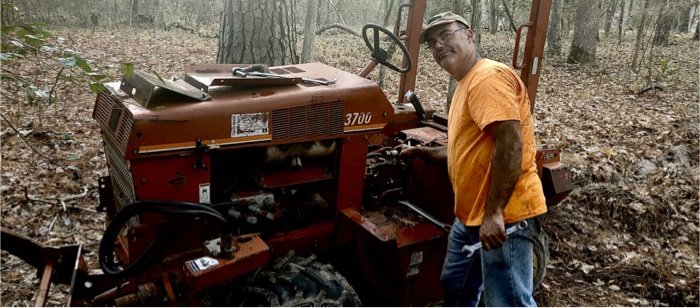
If you are building a DIY FTTH network, it helps to be a "Jack of
All Trades" because you may need to fix hydraulic hoses on your
equipment like Jamie can.
What type of system did you choose?
I looked at several topography methods and distribution systems. In the
end I chose the GPON system with a field split topography for price and
performance reasons. I looked at the 3 main GPON equipment providers but
when it was time to make the decision they all told me they could not
guarantee customer- end equipment (ONU/ONTs) and orders were as much as 6
months or more out with limits of 50 pieces. There were stories of
ISP’s not being able to add customers for lack of equipment. I wasn’t
sure if this was a legitimate shortage or a sales ploy to lock in early
orders but I couldn’t take that chance. I widened my search and finally
decided to contract manufacture my own GPON system from a large provider
overseas. I had to buy in bulk but they promised to have the entire
project worth of equipment manufactured and at my door in 30 days and
they came through as promised. I now have enough equipment to build
another community after this one as well as OLT spares. As an added
benefit this allowed me to tailor the specs to my needs and have the
items factory branded with LCS logos. I also offer VoIP telephone
services for those reluctant to abandon the telephone company and their
long-time home telephone numbers, which has been about 10% of our base
so far.
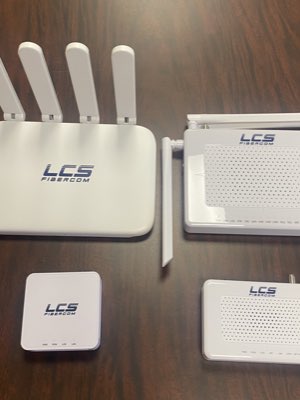 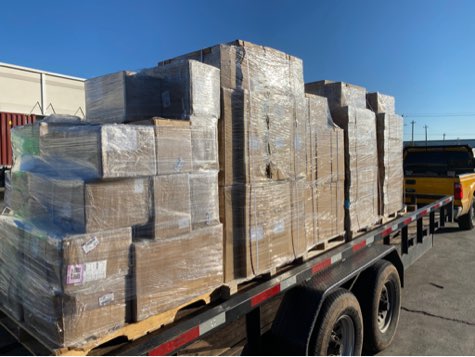
When suppliers couldn't provide products, LCS created their own.
Jamie had the electronics experience to do this but not every company
could. And it takes truckloads of equipment to build a FTTH network.
Have you been happy with the results?
I currently offer symmetrical 100Mbps and Gigabit plans. I’ve considered
offering a middle range plan as well as a 2-gig download option in
select areas but haven’t decided if I want to deal with the headache of
upgrading customers to multi-gig networking hardware yet. The network
handled the additional test demand well. We are too far out to have
redundant fiber ring options so we connect to our data center on a
single transport path. We had an outage on that path in May when the
main cable was severed in an adjacent city that took the provider half
the day to repair. Our local system has been working at a 100% rate.
What are your favorite and least favorite parts of construction?
I enjoy most of the construction. I have become quite a good horizontal
drill rig operator but I’m going to say using the large quad plow to
muscle in conduit at 4 feet deep several thousand feet per day is always
fun. My least favorite is probably just the Groundhog Day feeling of
chipping away at such a large amount of work day after day. I’ve worked 7
days a week for 18 months, averaging about one day away per month. At
some point I will be able to reduce my workload to something healthier
and more sustainable. It’s funny though, the few days I have taken off I
almost feel guilty about, thinking “I could have reached that goal
point today”. This type project definitely becomes all-consuming, at
least for me it has.
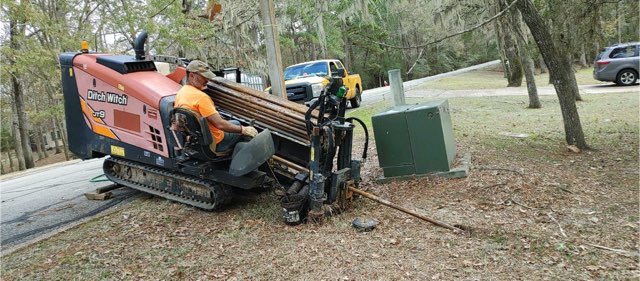
Jamie, like his mentor Greg Turton, likes to do construction work himself.
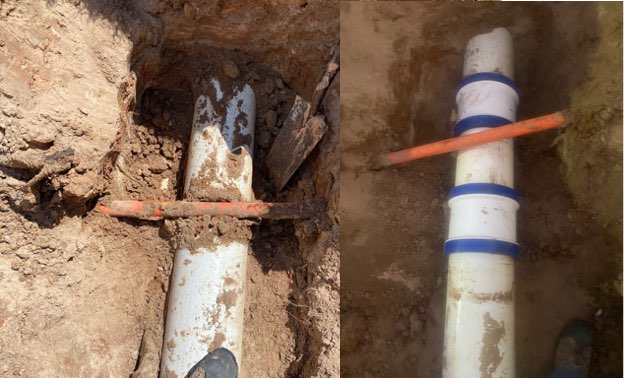
Not everything goes right - a water main for a golf course was damaged while directional boring and repaired.
What skills do you rely on most for this project?
All of them! When you take on a project like this you become engineer,
technician, politician, foreman, import specialist, customer relations,
field mechanic, salesman, contract negotiator, legal expert, government
liaison, plumber, electrician and more. You have to plan for some steep
learning curves because most people may have two or three of those
skills honed well, but you need all of them and more to keep moving
forward and give you a chance at success. I am very thankful for the few
people who have stepped in to help me where they can.
What would you do differently in hindsight?
Tough question, I don’t like to second guess past decisions. Looking
back there are some minor things that could have been improved but
overall, I was extremely fortunate that the decisions I made worked out
so well. It could have easily gone south if some of the non-traditional
choices didn’t work out well. Lots of research and asking questions
helped. My fiber management skills have improved a lot with practice so
at some point I will probably go back into the early splice points and
pedestals to organize them better but they are all working fine as is so
that is low on my to-do list.
Are your customers satisfied?
That is my main focus and I think I’ve done pretty well with that. I
personally meet with each customer at installation time and try to
follow up shortly after installation. The biggest issue I’ve had is the
same across the entire industry, customer’s WiFi expectations. I try to
assess each customer’s needs for WiFi at their home and educate them on
how to meet their expectations on their budget. I provide a wifi router
with the service but some customers with larger homes expect a one-size
fits all solution that just isn’t realistic. I make it a point to
explain the differences between extenders and mesh systems and why
getting their full gigabit to a single device over wifi is a tall order
even with their large 8 channel 5400 Mbps WiFi-6 gaming routers. It
amazes me that larger providers do all this work to bring service into a
customer’s home and then let their reputations suffer because the
customers experience poor service with the last 50 feet of connection
over underperforming wifi.
Did the pandemic cause problems?
Of course! I could write an entire article on those issues. It caused
delays for parts to repair equipment, labor shortages, cost increases,
and electronics equipment availability concerns. Our upstream provider
delayed our primary connection for several months as their crews were
constantly in some form of isolation or emergency coverage for most of
2021
How much has it cost, are you turning a profit yet?
A lot. I started doing initial budgeting and set my numbers in late 2019
which were used when the project started. The pandemic followed by the
government throwing billions of dollars to large providers to upgrade
their networks caused prices to increase substantially, as much as
triple on some items, and sub-contractors to be in short supply with
their prices increasing by 50-100%, and more recently the Fed’s interest
rate hikes have made profitability that much harder to reach.
I initially decided to keep total costs manageable by doing the bulk of
construction in-house so fortunately there was a degree of insulation
from the chaos going on in the fiber world but all the major materials
needed for construction have increased substantially since my initial
budgeting. Despite those issues and Waterwood having low home density
with so many miles of undeveloped lots to pass and 6 miles to bring
initial service into the community, I managed to keep the total cost per
passing at manageable levels by doing the bulk of the work with only
myself and one or two guys.
Recently I have been able to bring on an operator for the boring rig
with one or two of his guys because his machine is out for major
repairs. This has allowed me to catch up with splicing and getting
customers connected. To date we have 102 customers connected after
installing 70,000 feet of conduit and 170,000 feet of fiber-optic
cabling. We have 15,000 feet of conduit and 30,000 feet of cable left to
install with 200 more customers waiting for service. I expect to have
most connected by summer.
What is next for LCS Fibercom?
I’m looking for other areas to expand into and potential municipal or
utility partners to work with in the future. I laid the groundwork for
the network to expand into non-contiguous areas so I’d like to find
another community that wants improved services and keep growing.
More about LCS FiberCom
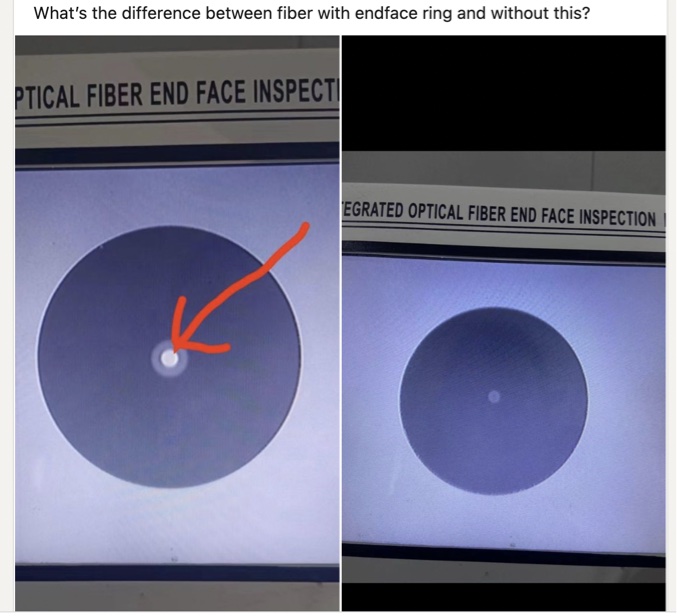
The fibre on the left is bend-insensitive G.657 fiber with optical "trenches" surrounding the core. On the right
is a conventional G.652 fiber.
FOA Is Converting To Online Credentials For All New And Renewal Certifications
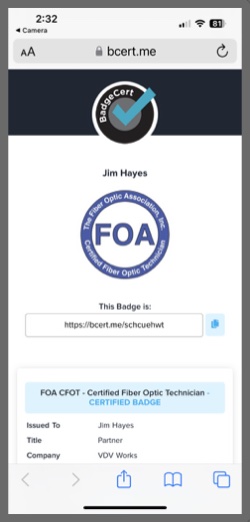
FOA will start issuing credentials for all certifications online in 2023.
Instead of a paper or PDF ID card, all new and renewal certifications
will be issued electronically and viewed online. One online certification will list all the FOA certifications the person
holds. Users can access their credentials any time, post the credential on LinkedIn, Facebook and other
social media platforms. AND they can print themselves a real paper
certificate!
The credentials are easily accessed on a PC, tablet or smartphone. And
you can print your online certification as a certificate anytime:
More information on FOA online certification credentials.
Latest FOA Book: Fiber Broadband (Paperback and Kindle)
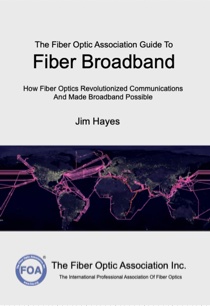 How does broadband work? Without fiber optics it would not work.
This book is not the typical FOA technical textbook - it is written for
anyone who wants to understand fiber broadband or fiber optics or the
Internet. It's also aimed at STEM teachers who want to include
communications technology in their classes. This book will try to
explain not only how fiber broadband works, but how
it was developed. It is intended to be an introduction to
communications technology
appropriate for a communications course at almost any level (junior
high, high school or
college,) for managers involved with broadband projects, or for anyone
who just wonders how all this stuff works. How does broadband work? Without fiber optics it would not work.
This book is not the typical FOA technical textbook - it is written for
anyone who wants to understand fiber broadband or fiber optics or the
Internet. It's also aimed at STEM teachers who want to include
communications technology in their classes. This book will try to
explain not only how fiber broadband works, but how
it was developed. It is intended to be an introduction to
communications technology
appropriate for a communications course at almost any level (junior
high, high school or
college,) for managers involved with broadband projects, or for anyone
who just wonders how all this stuff works.
The Fiber Optic Association Guide To Fiber Broadband Paperback ($12.95) and Kindle ($9.95) versions available from Amazon or most booksellers. Kindle version is in color!
New Fiber U MiniCourse - Fiber Optic Project Management
.jpg) Managing
a fiber optic project can be the easiest part of the installation if
the design and planning have been done thoroughly and properly, or, if
not, it can be the the hardest. It's certainly important to understand
what managing a project entails.
This new Fiber U MiniCourse starts by defining a fiber optic project
then explains what's involved in managing it from concept to operation. Managing
a fiber optic project can be the easiest part of the installation if
the design and planning have been done thoroughly and properly, or, if
not, it can be the the hardest. It's certainly important to understand
what managing a project entails.
This new Fiber U MiniCourse starts by defining a fiber optic project
then explains what's involved in managing it from concept to operation.
As usual with Fiber U online learning courses, the course is free and like the Fiber U FTTH course, the Fiber U Certificate of Completion is free also.
With so many new fiber optic projects starting up and so
many new managers, FOA decided this MiniCourse should also offer the
Fiber U Certificate of Completion free.
New Fiber U MiniCourse Fiber Optic Project Management
More Translations of FOA Textbooks
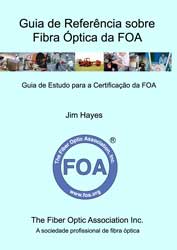 FOA is a very international organization and it works hard to
accommodate the language needs of everyone. We have been translating our
books and website into the languages most requested, and this month, we
add two more textbook translations. We also want to thank Jerry Morla,
FOA CFOS/I instructor and Director who has been doing the recent
translations into Spanish, his native language. FOA is a very international organization and it works hard to
accommodate the language needs of everyone. We have been translating our
books and website into the languages most requested, and this month, we
add two more textbook translations. We also want to thank Jerry Morla,
FOA CFOS/I instructor and Director who has been doing the recent
translations into Spanish, his native language.
Details below.
Cross Reference Guide to Textbooks, Online Guide and Fiber U FOA Videos Guide.
FOA has a web page with resources on fiber broadband and the IIJA/BEAD funding programs.
FOA Newsletter
Sections
News
Technical
Worth
Reading Q&A
Training/FiberU
Resoures
Safety About
|
|
News
Lots more news
in Worth Reading below
|
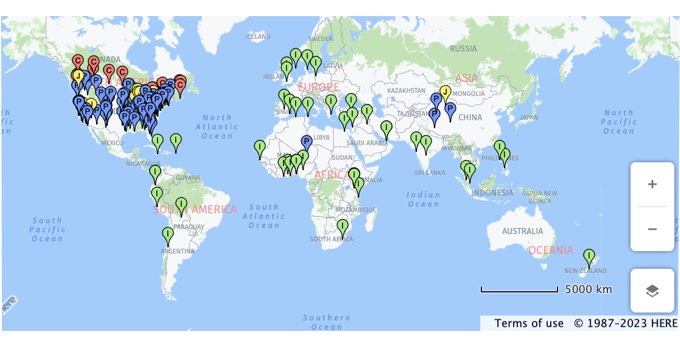
TIA BEAD Success Summit
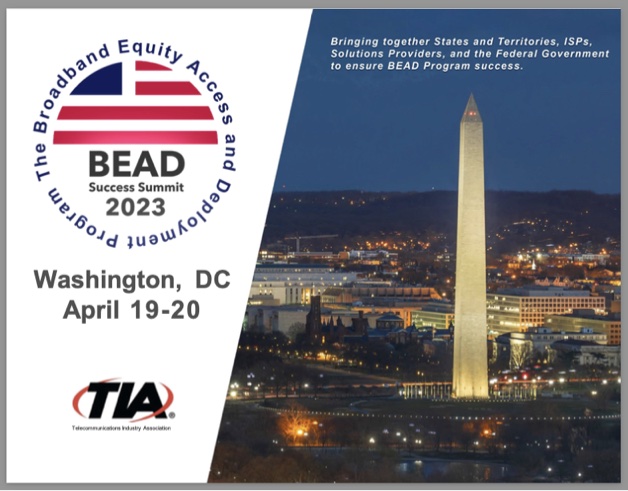
The US government's BEAD program has created plenty of speculation about
what it means and how it will be implemented, not to mention a lot of
hard selling of products and services that might be involved. If you are
tired of the speculation and sales pitches, this might be the
conference for you.
TIA, of course, is best known for it's work in standards, but its
location in Washington, D.C. and connections into the various federal
agencies and Congress gives it unique insight into the progress of the
IIJA/BEAD programs. And a lot of what has been said over the last year
is speculation as the actual programs take shape, so now is a much
better time to get a more down-to-earth viewpoint on the programs.
In addition TIA has a unique focus on supply chain issues, cyber
security and privacy, important areas of concern in broadband networks
that should be of interest to those planning or operating broadband
networks.
The timing of this conference could be good for getting updated on the BEAD program, since all states have
received their initial BEAD planning funds but the next steps depend on
the FCC broadband availability maps. They were released late last year,
but we hear that number of comments on the maps is in the hundreds of
thousands.
Information and registration on the TIA BEAD Success Summit.
More information on TIA efforts to support the NTIA BEAD program.
Need Help With Your OJT Program?
Or just looking for a good online fiber optic course? The FiberWizards Essentials - CFOT Prep Course could be a solution
How do you get new hires up to speed quickly? Continue training current
employees and prepare them for the certification your customers are
requiring? OJT - On-The-Job-Training. - is the usual answer, but an OJT
program like the FOA's OJT-To-Cert program - requires a commitment from experienced techs and supervisors to ensure the techs stay on course.
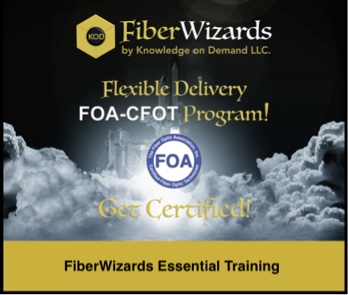
FOA Master Instructor and Director Jerry Morla has a solution that can
work for most companies, the "FiberWizards Essentials - CFOT Prep
Course." Students will get lots of flexibility to learn on their
own terms with a very tailored and personalized experience including
one-on-one coaching, virtual presentations, online modules, and access
to a private Slack channel for support.
Students will get a lab kit when they join, to explore behaviors of
light in fiber on their own. If the students need equipment to complete
the hands-on part of the course, FiberWizards offers rentals of
equipment and consumables kits for students within the Continental US.
For companies who need to train their fiber techs but lack the time
commitment needed from their top techs, which is practically all of
them, the FiberWizards course could be a very good - and cost effective -
solution.
FiberWizards Essentials - CFOT Prep Course
FOA Supports Austin, Texas Art Contest To Promote Digital Inclusion
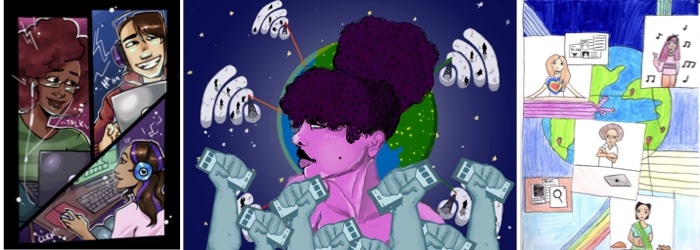
The Community Technology unit of the City of Austin hosts an art
competition in honor of Digital Inclusion Week, the first week of
October every year. Submitted artwork will be used in Digital Inclusion
marketing throughout the year, and may be hosted in various gallery
spaces, either digitally or physically at public libraries across the
City!
The City's Community Technology and Telecommunications Committee
announced the 2022 Digital Inclusion Youth Art Contest top three winners
at their Dec. 13 meeting. University of Texas at Austin student
Rhiannon Ferguson, 18, won first place and a $400 award (on the left).
Second-place winner Anvi Upadrashta, 10, a Long-View Micro School
student, won $200 (image on the right). The third-place prize of $100
went to New Tech Middle School student Jose Rivera, 13 (in the middle.)
"Congratulations to all the young artists who submitted their art work.
There's a lot of creativity in Austin. And a big thank you to all the
digital inclusion "cheerleaders" who shared the information about the
art contest and helped make it a success." A virtual gallery of all the
art work submitted since the contest began in 2020 can be viewed here.
Submissions for the 2023 Digital Inclusion Youth Art Contest are open
now through Sept. 30, 2023. The theme is digital inclusion and equity.
Please share the information. Additional details are available at
https://airtable.com/shrQGzC3YvZOD3zDa
FOA was supporter of the 2022 competition and wanted to share the winners with our readers.
Fiber Optic Design Certification For Traffic Engineers
IMSA,
the professional society of traffic engineers, is now offering a
certification course in fiber optic network design for the new IMSA/FOA
CFOS/D certification. Based on the FOA CFOS/D, it is another
certification program from the cooperation between IMSA and FOA. IMSA
has been offering the IMSA/FOA CFOT basic fiber optic certification
since 2017. The new certification is aimed at engineers in
municipalities and transportation departments who are responsible for
designing the fiber optic networks CFOTs install.
"Working with the Fiber Optic Association, Inc., we have built this new
certification to go beyond the initial Certified Fiber Optic Technician,
which covers the basic installation of ITS, Traffic, Fire Alarm and
Communications systems. The new fiber optics design class will improve
skill sets and certify that recipients are now qualified to design fiber
optic systems."
"Certified Fiber Optic Specialist/Design delivers on our promise to
offer tests that reflect the kinds of advanced technology our members
encounter every day,” said IMSA Board of Directors President Kevin
Musick.
AT&T and BlackRock to Form Gigapower Joint Venture – A Wholesale Fiber Services Provider
AT&T* (NYSE:T) and BlackRock Alternatives (BlackRock), through a
fund managed by its Diversified Infrastructure business, have signed a
definitive agreement to form a joint venture that will operate a
commercial fiber platform. The newly formed joint venture — Gigapower,
LLC — expects to provide a best-in-class fiber network to internet service providers (ISPs) and other businesses across the United States.
Gigapower will serve customers outside of AT&T’s traditional 21-state wireline service footprint
with fiber access technologies in innovative and efficient ways. And
AT&T will leverage its nationwide wireless sales capabilities to
sell fiber to customers in Gigapower territories.
“Now more than ever, people are recognizing that connecting changes
everything” said John Stankey, CEO of AT&T. “With this joint
venture, more customers and communities outside of our traditional
service areas will receive the social and economic benefits of the
world’s most durable and capable technology to access all the internet
has to offer.”
“We are excited to form the Gigapower joint venture in partnership with
AT&T, which will be serving as not only a joint owner but also the
first wholesale tenant. We believe Gigapower’s fiber infrastructure
designed as a commercial open access platform will more
efficiently connect communities across the United States with critical
broadband services,” said Mark Florian, Global Head of Diversified
Infrastructure, BlackRock. “We look forward to partnering with
Gigapower’s highly experienced management team to support the company’s
fiber deployment plans and shared infrastructure business model.”
Gigapower plans to deploy a reliable, multi-gig fiber network to an
initial 1.5 million customer locations across the nation using a commercial open access platform.
The Gigapower fiber deployment will be incremental to AT&T’s
existing target of 30 million-plus fiber locations, including business
locations, by the end of 2025. Combined with existing efforts within
AT&T’s 21-state footprint, this capital efficient network deployment
will advance efforts to bridge the digital divide, ultimately helping
to provide the fast and highly secure internet people need. This network
expansion will also help spur local economies in each of the
communities in which Gigapower operates.
“Fiber is the lifeblood of digital commerce,” said Bill Hogg, CEO of
Gigapower. “We have a proven team of professionals building this
scalable, commercial open access wireline fiber network. Our goal is to
help local service providers provide fiber connectivity, create the
communications infrastructure needed to power the next generation of
services and bring multi-gig capabilities to help close the gap for
those who currently are without multi-gig
service.”
Following close, AT&T and BlackRock will jointly own and govern
Gigapower. AT&T does not expect to consolidate Gigapower’s financial
results but does expect to report its consumer subscribers served
through Gigapower in Consumer Wireline business unit operational
results. Any impacts to AT&T’s 2023 capital investment or free cash
flow forecast will be included in AT&T’s 2023 financial guidance
when it announces fourth-quarter 2022 results in January 2023.
From the AT&T Web Site, italics by editor.
|
Technical
Fiber optic
technology, standards, equipment, installation,
etc.
The FOA
Update Page covers the new technology
and applications we covered in this newsletter
recently. Now you can review all that new tech at
once.

Cross Reference To FOA Technical Reference Materials
The FOA has almost 1,000 pages of technical information on the FOA Guide,
100+ videos and two dozen online courses at Fiber U, all this can make
it difficult to find the right information.
Cross Reference To FOA Tech Materials
To help this, we have created a cross reference guide to the textbooks,
Online Guide and Fiber U courses, all the FOA technical information.
Besides the textbooks, online Guide and Fiber U, each section of the
Guide also includes links to the 100+ FOA videos available.
Cross Reference Guide to Textbooks, Online Guide and Fiber U
FOA Videos
We have also rearranged the 100+ FOA videos in similar categories on the
Contents Page of the Online Guide, making the videos, especially the
lectures, much it much easier to find a video on a particular
topic.
FOA Videos Guide.

Want to know more about fiber optics? Study
for FOA certifications? Free
Self-Study Programs are on Fiber
U®
|
 OptConn
is a value-add re-seller of optical connectivity products, services and
solutions. With over 30 years of experience in the fiber optics
industry we are here to serve your requirements from fiber optic
training with FOA certification to products, materials and supplies. OptConn
is a value-add re-seller of optical connectivity products, services and
solutions. With over 30 years of experience in the fiber optics
industry we are here to serve your requirements from fiber optic
training with FOA certification to products, materials and supplies.
We have partnerships with industry leading
manufacturers to support your installation, splicing and testing needs.
Our goal is to guide, support and recognized our client’s requirements.
Learn more about OptConn
|
How Small Can Cables Get? Prysmian 864 Fiber Cable Has Only 11mm Diameter
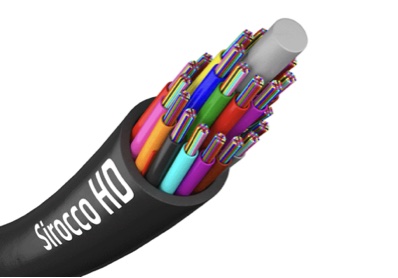
Prysmian has announced its Sirocco HD line of microduct cables now
includes an 864-fiber cable. The new cable squeezes 864 fibers into a
diameter of 11.0 mm, providing a fiber density of 9.1 fibers per mm2,
and is installable into a 13mm duct. The Sirocco HD line of microduct
cables are available in fiber counts from 96 to 864 fibers.
The Sirocco HD microduct cables utilize Prysmian’s PicoTube technology,
making them up to 20% smaller than previously available microduct cables
and BendBright-A2 200µm single-mode (ITU-T G.657.D, G.657.A2) bend
insensitive fiber, providing a cable that is futureproof and ready for
use in evolved FTTx and 5G systems, but also compatible with any
already-installed legacy G652 fiber.
Fake OTDR Traces?(Jan 2023)
FOA gets some very interesting technical questions, but this month we received a really unique one:
I have been an external plant technician since 1998. I carry out
OTDR testing for trunk links, metro, etc. for various operators and
private companies.
A few months ago I was given a series of .SOR files from some
links. I am sure that these measurements are false and I have been
looking for someone for some time who might know how they have done
these tests, to unmask the lie and I thought that you might have seen
something similar.
What leads me to think that they are false, would be several
details, the weight of the file is almost ten times greater than a
normal .SOR file. The times of taking the measurements have differences
of 4 minutes OE-EO, the losses of the events are exact, in the trace
information the averaging time is 0.
I think they use an emulator to make these traces. Have you seen something similar?
Here is one of the traces (Click on the trace for a larger version -
right click and open in a new window so you can follow some of the
comments below):
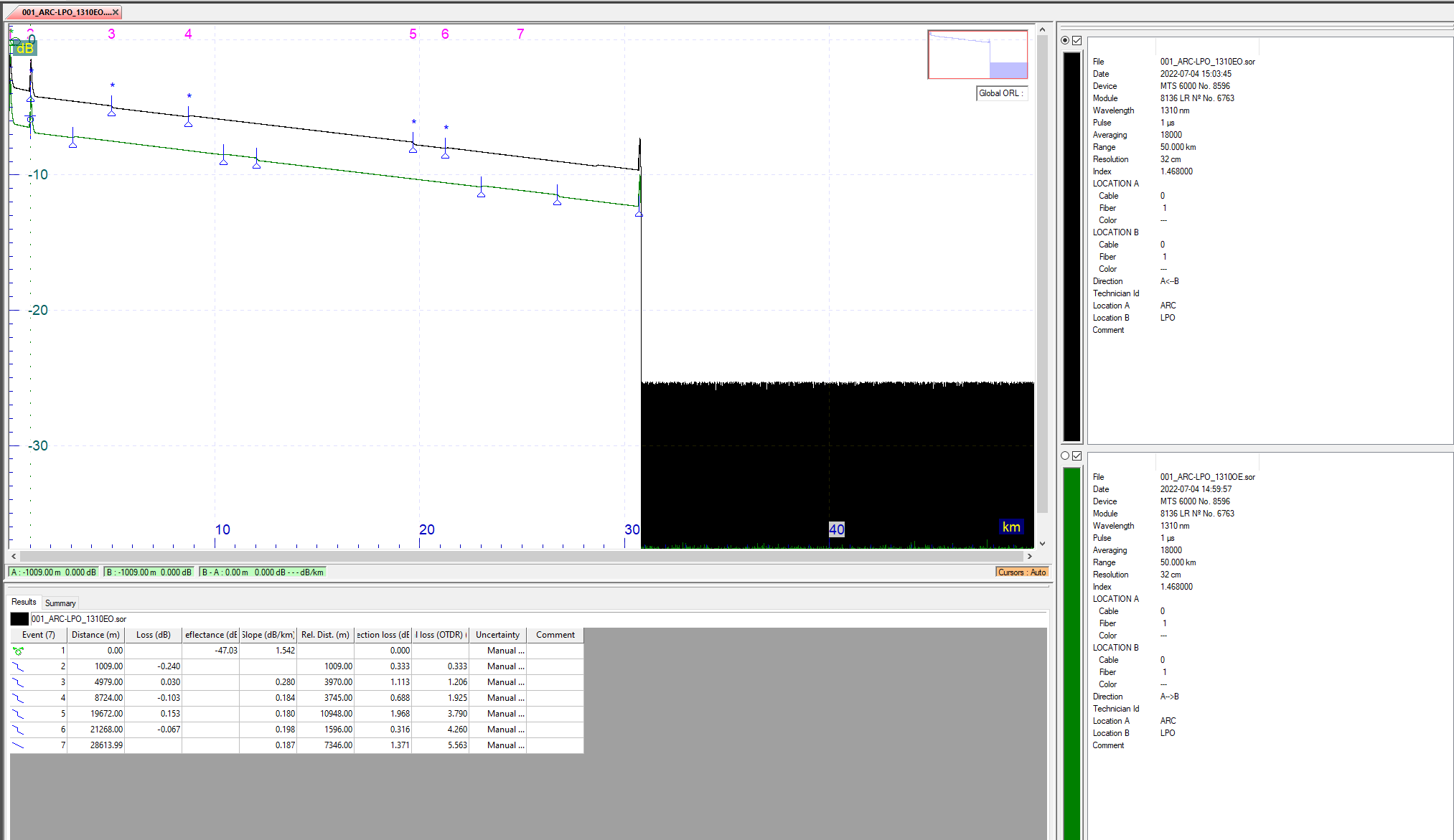
We sent the traces to a contact at VIAVI who had their technical people analyze the SOR files. Here is what they saw:
It did not take too long for a colleague of mine to agree that these are fake traces. Below is his assessment: Easy to identify :
Noise on trace too regular

Stochastic noise too homogenous


Distance range cannot be exact to km on each end and is almost never round number like that.
Number of averages never reaches a round number like 18000, and it is
not possible to have the exact same numbers from each end. Viavi doesn’t
provide nb of averaging but acquisition time.
True on the weight of the sor file - it's too big.
This file is not a Viavi/JDSU file because our detection algorithm
cannot re-evaluate the trace – this tells me there is no acquisition
points (dB vs. time)
The conclusion is correct. This is a fake OTDR trace created by a simulator.
Managing Fiber Optic Projects - The Gantt Chart
(With An Excel File To Make Your Own)
The most common way to track projects is the Gantt Chart, a
chart of activities that tracks the progress of projects along a
timeline. each activity is represented by a bar and the position and
length of the bar represents the starting date and duration of the
activity. This allows you to see what activities are needed for the
project, when the activities start and end so it can be used to track
the progress of the project visually. Here is what a Gantt Chart for a
fiber project might look like:
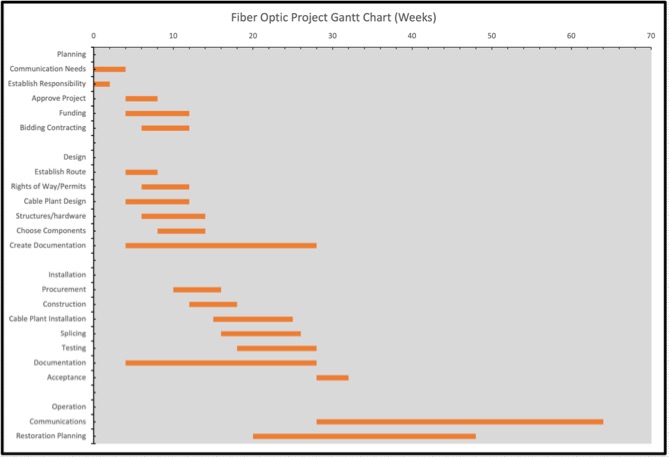
You might remember an article in the FOA Newsletter in April 2022 or the FOA Guide page on Project Management about the timing of a fiber optic project where we showed the progression of steps in a project like this:
The Gantt Chart above is simply this list converted to a Gantt Chart
using a Microsoft Excel spreadsheet. You can download a copy of the FOA Gantt Chart spreadsheet (xlsx file - 16kB)
and use it to create your own Gantt Chart for any project. All you have
to do is to input your own data and change the activity names as
necessary. You can also follow the directions from Microsoft to create your own version.
More Help On Color Codes (Now Copper Cabling And Fiber Optics)
The FOA has created a pocket guide to fiber
optic color codes that we are sending to new and renewed CFOTs. It has
color codes for fibers and buffer tubes, connectors and premises cables
inside and on the back, QR codes to take you directly to the FOA Guide
and Fiber U.

The FOA
Guide page on Fiber Optic Color Codes is one of the most read pages on the FOA
website and the Fiber Optic Color Codes minicourse on Fiber U very popular also.
Here's a do-it-yourself FOA Guide To Fiber Optic Color Codes card.
Just download the PDF file, print it on a color printer and fold it up
as shown. Then you have your own pocket guide to color codes. Make a
bunch for your co-workers too.
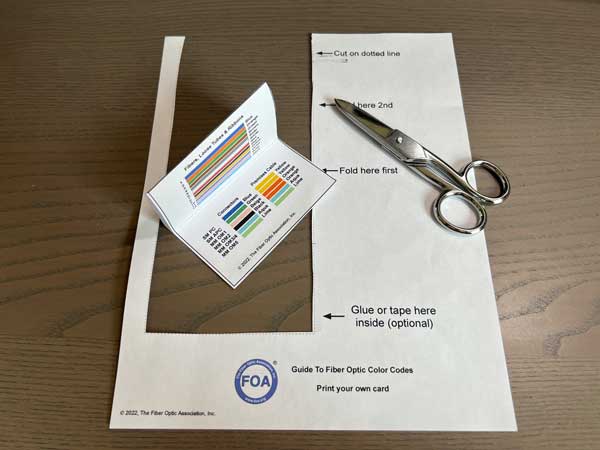 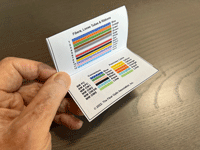 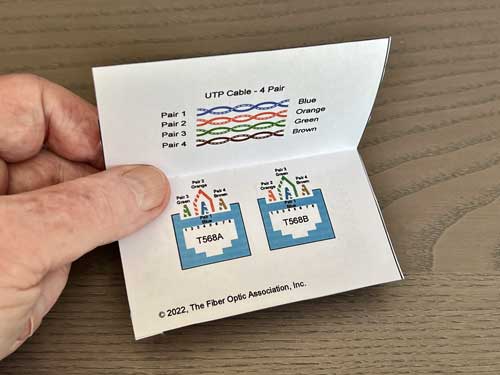
Then we realized that many of your also do structured cabling
work, so it was a natural to add a Color Code Guide for UTP copper
cabling in printable (below) and electronic (above) versions.
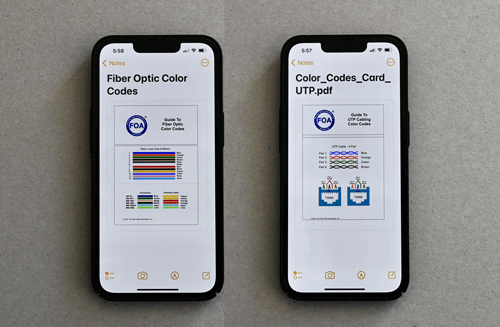
But we did not stop there. We know how many of you use your mobile devices on the job, so we created a version of the Color Code Guide you could download
and use on your smartphone or tablet. It's a PDF file, so you just
download it and save it on your device and it will be with you always.
Here are the links to download your own FOA Guides to Fiber Optic Color Codes
FOA Guide to Fiber Optic Color Codes (print your own version) PDF
FOA Guide to Fiber Optic Color Codes (electronic version for your smartphone, tablet or PC) PDF
And For UTP Cabling
FOA Guide to UTP Cabling Color Codes (print your own version) PDF
FOA Guide to UTP Copper Cabling Color Codes (electronic version) PDFWarning For Techs Doing OSP Restoration
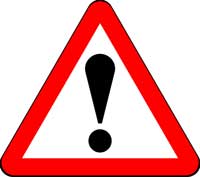
FOA received an inquiry about whether techs
working on restoring OSP links should be concerned about eye safety if
the link used fiber amplifiers. To answer this question, we had to do some research on fiber amplifiers.
The short answer is YES, you should be concerned. The long answer is
more technical and includes details that every OSP tech needs to know.
See "Fiber Amps And Restoration" in the FOA Newsletter Archives..
Try The FOA's Online
Loss Budget Calculator
FOA
has written many articles about loss budgets,
something everyone involved in fiber optics needs to
know and needs to know how to calculate. We've
created a online Loss Budget Calculator that does
the work for you. Just input your cable plant data
and it calculates the loss budget. It works on any
device, especially smartphones and tablets for field
use and even allows printing the results.
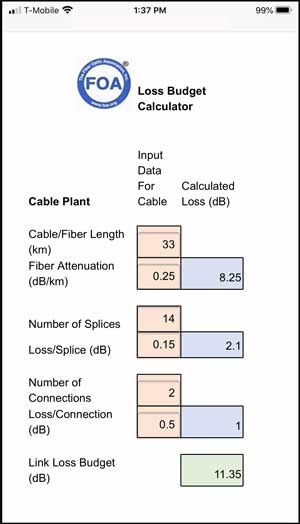
Bookmark
this page (especially on your smartphone): FOA Loss Budget Calculator
Online
|
Worth Reading
Each month we read
hundreds of newsletters and online articles. These
are the ones we think you will find "worth
reading."
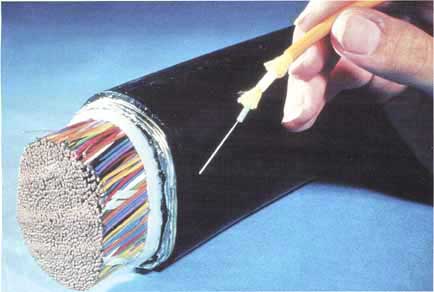 AT&T PR photo from the mid 1970s AT&T PR photo from the mid 1970s
The FOA's History
|
Worth Reading (And
Watching):
FOA has a web page with resources on fiber broadband networks and the IIJA/BEAD funding programs.
Cross Reference Guide to FOA Textbooks, Online Guide and Fiber U
February 2023
Friday the 13th Mapping Challenge Deadline Highlights Failed Process -
The new national broadband map challenge process - crucial for future
infrastructure funding - looks to have been hamstrung by critical
lacking information from the start, and that has us worried.
Ask The Experts: What Defined The Industry in 2022? Telegeography
Review Telegeography's Presentation On the 2022 Fiber Optic Market
E.U. mulls requiring tech companies to pay for telecom upgrades -
Washington Post. The European Union is considering a proposal that
would make technology companies that use the most data, like Google and
Netflix, to help pay for upgrades to internet infrastructure, Bloomberg
News’s Jillian Deutsch reports.
January 2023
The 45 Year Old Overnight Sensation - article by FOA President Jim Hayes in ISE Magazine (Read the complete Nov/Dec issue of ISE Magazine here.
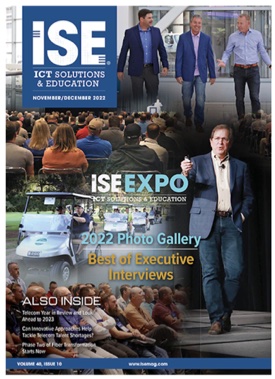
It's Science Time At Linden - Linden Photonics describes some of their really interesting customer's projects with specialty fiber optic cables.
Going
the distance: What you need to know about breaking the 100-meter
distance limitation Cheating on the standards for UTP cable - CI&M Magazine
FCC Requires Broadband Providers to Display Broadband Nutrition Labels not
nutrition labels on the product's "high fiber content" but key
information consumers want−prices, speeds, fees, data allowances, and
other critical information.- Broadband Communities
I can’t hear you now: How to fix the bad audio on cellphones Washington Post
Fiber
optics take the pulse of the planet It’s like radar, but with light.
Distributed acoustic sensing — DAS — picks up tremors from volcanoes,
quaking ice and deep-sea faults, as well as traffic rumbles and whale
calls. Knowable Magazine.
December 2022
Fibercore's on-demand webinar entitled "Lighting up the Body - Fiber Optics for Biomedical Applications"
takes a look at Biomedical applications currently using fiber optic
technology to enhance performance and results, looking at a range
specific industry examples.
Optical Fiber Capacity Limits – Where Do We Go Next? Infinera
The New Broadband Maps Are Finally Here FCC
Verizon plans upstate NY Fios expansion at $12k per passing Fierce Telecom
Head of Google Fiber Says They're Ready To Start Building New Cities - Reuters
From Earlier Issues
ESRI has created an ebook on GIS location technology for telecom. Use the link to download the book.
The First Transcontinental Telephone Line
began operation on July 29th in 1915 - 3400 miles between New
York and San Francisco - required over 100,000 telephone poles! Wonders
of World Engineering
Conocimiento Esencial: ¿Por qué la fibra óptica? creado por FiberWizards
Recruiting And Training Today's Fiber Optic Workforce - Learn the fundamentals to recruit and train new fiber optics - by FOA's Jim Hayes in ISE Magazine.
Explosive Fiber Broadband Expansion Drives Need for Fiber Technician Training Programs
- Telecompetitor - As fiber sees record-setting deployment levels, the
demand for fiber optic technicians is stronger than ever.
Google Video On Their Undersea Cables YouTube Slick but interesting video on how undersea cables are designed, built and used.
2022 Submarine Cable Map depicts 486 cable systems and 1,306 landings that are currently active or under construction. Telegeography.
Construction Without Disruption - FOA President Jim Hayes' column in ISE Magazine
Fiber Optics Installed By The Lowest Bidder - ISE Magazine - by Jim Hayes, FOA President.
Building Broadband During Component and Worker Shortages
- Broadband Communities - Completing broadband builds requires
competent fiber optic techs, but training them requires understanding
how they learn - by Jim Hayes, FOA President.
Worth Reading - Magazines, Websites and Newsletters
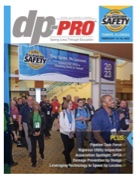
The
latest Issue of
dP-PRO, the "call before you dig" magazine, is
online.
dpPro sponsors the annual digging safety conference each year - next year in Tampa.

New Fiber Optic
Magazine In Spanish
Todo Fibra Optica is
a new digital magazine in Spanish for fiber optics
in Latin America and South America. Jose Enriquez, editor of Todo
Fibra Optic magazine has many years
experience in the fiber optic industry so he knows
the industry well. FOA will be working with him to
share our extensive technical materials in Spanish.
Read their newsletter here. It is now available online in English and Spanish.
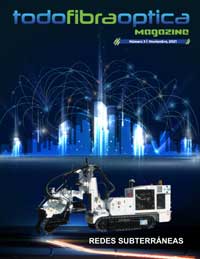
All issues and subscriptions.
Contact:
José Manuel Enriquez Mora, Editor
Todo Fibra Optica LLC
https://todofibraoptica.com/revista-ediciones/
+52 222 302 8224
jose.enriquez@todofibraoptica.com
RTI Telecom Magazine from Brazil, in Portuguese. A revista RTI do mês de abril já está disponível online e recomendo a leitura de alguns artigos:
1995-2020
- FOA's 25th Anniversary!
As
part of celebrating 25 years of serving the fiber
optic industry as its primary source of technical
information and independent certifying body, FOA
thought it appropriate to create a short history of
the organization and how it has developed to
help the fiber optic industry. We also wanted to
recognize the contributions many people have made to
the organization over the years that made FOA what
it is today.
The FOA history is now archived on the FOA
website where you can read it anytime or link to
it. Updated
info - dB, total internal reflection and science
projects,
Worth Reading - News
Summary - Past Links Worth Repeating
1983
Video of AT&T's First Test Of A Submarine
Cable System From the AT&T Tech
Channel archives (worth exploring!)
Richard
Epworth's Optical Fiber History from his work
at STL from 1966 with Charles Kao.
Communications Systems Grounding
Rules: Article 800 provides specific
requirements by
Michael
Johnston, NECA Executive Director of
Standards and Safety in EC Magazine
US Broadband Coverage By Service
Provider from the FCC
How
To Build Rural Broadband, Learning From History
In the August 2021
FOA Newsletter, we published a lengthy article on
rural broadband and compared it to rural
electrification in America in the last century.
Much of the comparison was based on an article
written in 1940 by a USDA economist, Robert Beall,
called "Rural Electrification."
If
you are interested in or involved in rural
broadband, we recommend you read the article "How
To Build Rural Broadband, Learning From History"
in the August 2021 FOA Newsletter and
read the Beall article also.
Recycling Fiber Optic
Cable - Contact:
Steve Maginnis
LD4Recycle/ CommuniCom Recycling
(Visit
website)
sm@LD4Recycle.com
803.371.5436
Sumitomo's Ribbon
Splicing Guide - download from
one of the leaders in splicing.
"Who Lost Lucent?: The
Decline of America's Telecom Equipment Industry"
This is a MUST READ for managers in telecom or any
industry!
This long and
well-researched and annotated article in American
Affairs Journal should be mandatory reading
for every high level manager in a telecom company -
or any other company for that matter. To summarize
the article, today, America has no major telecom
equipment company and fears the major suppliers of
equipment who are all foreign, especially the Huawei
from China. This article explains how America got
into this deplorable state.
OFS also has an excellent
website and blog of tech articles worth browsing.
IEC 60050 - International
Electrotechnical Vocabulary - An
extensive dictionary for fiber optics in English and
French. Highly technical - this is one definition:
"mode - one solution of Maxwell's equations,
representing an electromagnetic field in a certain
space domain and belonging to a family of
independent solutions defined by specified boundary
conditions"
If you are interested in restoration -
aren't we all? - you should also read this
article in dpPro magazine by FOA President Jim
Hayes: Damage Protection Requies
Looking Overheas As Well As Underground
- dpPRO Magazine - about the problems with
aerial cables. His previous article for the
magazine was New Techniques for Fiber
Optic Installation.
How much fiber optic cable is
manufactured each year? CRU Reports -
unsurprisingly China is by far the largest market
today
The Institute for Local
Self-Reliance weekly newsletter has
lots of interesting articles and links.
Universal access to broadband
is a cornerstone to a strong economy,
Achieving universal access will require
community partnerships. by Alfreda
B. Norman, Sr. VP, Federal Reserve Bank of
Dallas
FIBER TO THE FARM: The
co-ops that electrified Depression-era farms are
now building rural internet. Be sure to check out
the high-tech equine installation equipment.
Next Century Cities Newsletter
- News from cities around the US
including Detroit and New York plus small
Infrastructure Get Some
Respect, NY TImes "On Tech"
"The magic of the internet requires a lot of
very boring stuff behind the scenes. "
DIRT
Report On Damage To Utilities Common Ground
Alliance (CGA) annual DIRT report provides a
summary and analysis of the events submitted into
CGA’s Damage Information Reporting Tool (DIRT) for
the year 2018. The complete report is available
for download here. In addition,
there is an interactive dashboard that
allows users to filter the data more by
factors contributing to damages.
Structured Cabling News
- a website and weekly newsletter about cabling.
Fiber Trivia From
Corning.
The
Future Of Work Is Skills - So Stop Worrying
About Degrees - The
reality is the future of work is about skills, not
just degrees. (FOA Newsletter Feb 2020)
The job market is hot. So why
are half of U.S. grads missing out?
VIAVI Books On
Fiber Optic Testing (2 volumes) - They're back!
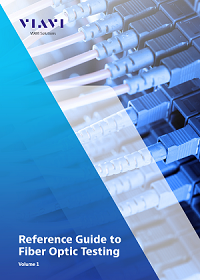 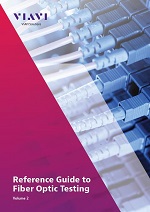
Besides
the FOA reference materials, two JDSU/VIAVI
textbooks, Reference Guide to Fiber Optic Testing,
Volumes 1 and 2, were used as references for
some of the FOA courses and are recommended for
instructors and students. The books are available
from VIAVI as eBooks and the everyone should
download them and recommend them to others.Download
yours now. Volume 1. Volume 2. Viavi Books
Ciena's Submarine Cable
Handbooks (4 to download)
Guidebook To MPO
Testing OptoTest
offers this complete guide to MTP®/MPO testing. In
this guide, you will learn all there is to know
about the different test methods, equipment
options, troubleshooting, and best maintenance
practices to ensure that you have the best testing
experience. Go here to download the book.
50th Anniversary of The
Development of Low Loss Fibers A history
of the development of low loss fiber, a fascinating
story by Jeff Hecht on the OSA (Optical Society of
America) website.
How OFS Makes Fiber
Interesting YouTube video on how fiber is made.
Perhaps a little too much "show biz" but
fascinating. If you have ever seen fiber
manufacture, look at this video. You will be amazed
at how big preforms have become!
The True Cost of Telco Damages
(what backhoe fade or target practice can
cost)
Rural Electric Cooperatives:
Pole Attachment Policies and Issues, June 2019.
Clearfield-FOA Certification
Training Clearfield is now offering
their customers an FOA
CERTIFICATION course. This course
provides a basic understanding of fiber optic
technology, as well as Clearfield product
knowledge and how Clearfield’s integrated product
systems work together in a fiber network.
Substandard Contractors - Fiber
Optic Knowledge Doesn't Always Trickle
Down (EC Mag)
|
Q&A
When readers ask us questions, we genrally refer them to FOA
resources where they can find the answer to their question and many
more. We first send them to the FOA Guide
which is the table of contents for the FOA technical resources. There
they can find pages indexed by topic and a search engine for the FOA
website. It also links them to FOA videos and courses on our free online learning site Fiber U.
The FOA
Fiber FAQs Page (FAQs = frequently asked
questions) gathers up questions readers have
asked us (which first ran in this newsletter)
and adds tech topics of general interest.
|
Good Question!
Tech
Questions/Comments From FOA Newsletter Readers
Also see the two important questions above in the Technical section.
February 2023
FOA Technical Materials Updates
Q: How often are FOA courses (such as
CFOS/D) updated? And when they get updated, what happens to those who
would have done a previous version?
A: The FOA knowledge base is updated continuously, reflected
first in the FOA Guide online (FOA Guide), then in the curriculum
materials for courses at our FOA Approved training organizations and
Fiber U (Fiber U). Textbooks are updated every few years, generally just
tech updates, but sometimes with major additions like the large section
on OSP construction added into the OSP book.
If you took your certification a few years ago, there are new courses at
Fiber U and a FOA Update Page that we use for new information that was
first published in the newsletter. And of course reading the FOA Monthly
Newsletter FOA News will help keep you up to date on fiber optic tech
and applications.
Measuring Short Cables WIth A Long Launch Cable
Q: Is it correct to measure a 300m fiber
optic last mile with a 2Km launch cable? I think it is not, but I’d like
to hear your comments.
A: Why would you think it is not correct?
Q: A 2Km launch box must be used with a 20uS pulse width, to
eliminate the dead zone. Shorter pulse widths are too “weak” so the OYDR
will not reach the end of the link. That’s why I think it’s not correct
using the 2Km launch box in links shorter than 80Km/90Km.
A: You have cause and effect reversed. If you are trying to
measure a very long fiber, 80-90km, you need a lot of power in the OTDR
pulse, so you use a very wide pulse. In order to get past the dead zone
with that long pulse, you need a long launch cable, like 2 km. But if
you are trying to measure a short cable, say 300m, you use a very short
pulse, 5ns or so, for higher resolution. The OTDR range would only need
to be a few km, so the shorter pulse works. As long as the OTDR range is
longer than the launch cable plus the cable to test, it’s perfectly OK.
A shorter launch cable would work and might even allow a shorter test
pulse for higher resolution, but the length of the launch cable only
needs to be long enough to reach past the dead zone and allow measuring
the cable you want to test.
January 2023
Fiber In Antarctica
Q: Does anyone know if there is any cable solution to be
installed in Antarctica? The climatic conditions involve installing the
cable directly on the ground, withstanding temperatures as low as -30°
Celsius.
A: There have been fiber optic cables in the Antarctic for over
25 years. In the 1990s, the fiber optic test equipment company FOTEC
built a computerized test system that was installed at
Amundsen-Scott base to test about a half-dozen cables over the winter.
All worked fine. A few years ago we met the engineer who installed it at
a conference. She told me some of those cables were still being used.
December 2022
Seeing Splices On OTDR Traces
Q: The reason why I am reaching out is because the CEI is
having trouble understanding that not all trace files will show splices.
As we both know that means that there is low loss and the network will
work more efficiently. I was wondering if you could possibly help give a
more in depth explanation so everyone can understand why they are not
seeing splices.
A: Nothing in fiber optics is more confusing that an OTDR trace!
First it is necessary to understand how the OTDR measures loss, so start
on this page in the FOA Guide:
https://foa.org/tech/ref/testing/OTDR/OTDR.html When you get about 3/4
down the page, there is a section called “OTDR Measwurement
Uncertainty” that explains the way a splice loss is measured and
the uncertainty of the measurement caused by the difference in
backscatter coefficient in the two fibers being spliced.
Next consider how a splice is made - fusing or welding two fibers
together. The typical loss of the splice is under 0.1 dB. The difference
in fiber backscatter can cause directional loss variations higher that
the loss of the splice. If the difference in backscatter is 0.1 dB and
the splice loss is 0.1 dB, in one direction it will show 0 dB loss and
in the other directin it will show 0.2 dB loss, so the average is about
right, 0.1 dB. This is of course how we get “gainers” when the
backscatter difference is much higher than the splice loss.
But also consider this. The OTDR digitizes the signals in both axes. If
the dB range shown is 40dB and the digitization is 10 bits, each bit
represents 0.04 dB. A good fusion splice can be so small, the OTDR
cannot detect it because it is less than 1 bit of the measurement
resolution.
This is the reason we tell people that documentation is so important. If
you know where the splice is, you can look for it and pat yourself on
the back if you can’t find it because you are so good at splicing!
What is the application for 10G to the home?
Q: What is the application for 10G to the
home? Streaming 4K requires 25M, even a family of 8, each watching
their own program would only require 200M.
A: The use of 10G is not just for bragging rights. With 10G,
you can serve up to 256 (or sometimes more) users, making it a viable
alternative for very dense populations. Of course, it can also serve
fewer business users who want higher bandwidth than regular GPON.
Utility damages slightly increased since 2019, per DIRT Report
The Common Ground Alliance (CGA) recently announced the findings from
its 2021 Damage Information Reporting Tool (DIRT) Report, and the datas
indicates that damages have increased since 2019.
November 2022
Fiber Characterization
Q: After installing a long haul backbone
fibre, what tests are required on the fibre plant to ensure optimum
performance of DWDM. (I understand the need for having OTDR traces.) Are
there any FOA Guides that explore such tests?
A: FOA has a page in the FOA Guide covering this kind of testing - it’s called “fiber characterization.” The page is Fiber Characterization and Testing long haul networks (CD, PMD, Spectral Attenuation)
Mating Cycles
Q: I’m a NASA contractor and recently we came across a interesting
and yet perplexing question. Does a connector lose a mate cycle
every time we put it under the scope for a cleanliness inspection?
We want to catalogue each time we lose a mating cycle and wondered if
that counted as well.
A: No you would not lose a mating cycle. The connector is well
separated from the lens of the microscope. If they touched, it would
disturb any dirt on the end of the connector you were trying to inspect
and get the microscope lens dirty. A mating cycle is only when mated to
another connector - PC and APC connectors have contact between the
polished fiber ends and that is what causes wear. Microscopes should not
cause mating, not should most power meters for testing, but test
sources and meters with fiber pigtails for connections would count as a
mating cycle.
Removing Data Center Cables
Q: I’m wrecking out fiber optic cables at the data center.
They get very tangled if the connectors are intact. Co-workers are
cutting the connectors off to make pulling the fiber optic cables
through the fiber troughs easier. I was concerned about fiber shards
when connectors are cut off.
A: Cutting off connectors should not produce fiber shards. The
plastic coatings on the fiber should keep that from happening. It is OK
to cut off connectors or cut the cables into shorter lengths to ease the
removal of tangled cables.
Connecting OS1/OS2 SM Fiber
Q: Can OS1 and OS2 fibers be cross-connected? Application is
for low bandwidth devices with a maximum of 1GB Ethernet connections.
A: OS1 and. OS2 (G.652) fibers are essentially the same
geometrically; the only difference is the manufacturing of OS2 removes
the water molecules that cause the water peak at 1244 and 1383 nm.
FTTH Software
Q: Do you have any recommendations on FTTH software? A search shows a
dozen or more offerings but I don’t know anyone using them. Are you
familiar with any?
A: We asked several people who are knowledgeable on software and here is what they said:
It would depend on the application or what you need the software for…
- For GIS based mapping: Esri
- For fiber network management systems (FNMS [design/planning and operations]): OSPinsight or Vetro
- For automated HL design: OSPInsight as well as Biarri
- For Tier 1 type telecom operator FNMS with
BSS/OSS integration: Ericsson NE (Networks) which was based on old
Tirks. Another is NetCracker.
- For GIS enabled construction / project Management: Vitruvi
If I had to start a small to mid sized FTTH system, I would consider ESRI and OSPInsight.
October 2022
How Light travels In An Optical Fiber
Q: Is there a generalised ratio between
the length of an optic fibre and the length of the path actually taken
by a light pulse inside that fibre? If yes, do OTDRs factor in such
differences in any way? or they such sown the length of the actual path
of the light pulses?
A: Each optical fiber has an effective
independent of refraction. The index of refraction is the ratio of the
speed of light to the speed of light in the material: n=c/v where
n=index of refraction, c=speed of light in a vacuum and v=speed of light
in the fiber.
For an optical fiber, the manufacturer measures the index of refraction
which is usually in the range of 1.47. Corning SMF-28 singlemdoe fiber
for example is specified at 1.4670 @ 1310 nm and 1.4677 @ 1550 nm.
So if you use the equation above, the speed of light in SMF-28 fiber for
a 1310nm pulse is c/n or 300,000 km/s divided by 1.4670 = 204,500 km/s.
When an OTDR measures length, it actually measures the time its test
pulse takes to go to the end of the fiber and return, so the distance is
2X the actual fiber length. The distance is speed x time.
If a fiber is 1 km long and the speed is 204,500 km/s, the time
forlight to travel the 1km is 1/204500 = 0.00000489 seconds or about 5
milliseconds.
OTDR will measure that fiber as 10 ms becasue its pulse has to go both
ways, and it would calculate the length as i km, using that effective
index of refraction of 1.4670.
Back to your original question, the index of refraction is the generalized number based on how light travels in the fiber.
Excess Cable In Ducts
Q: Do you have any established characterization on the
ratio of the length of optic fibre to the length of its duct (to account
for twisting of the fibre inside the duct).
A: The cable after pulling into the duct and no longer under
tension will be about 1-2% longer. And remember the fiber is about 1%
longer than the cable.
Slack/Service Loops In Manholes
Q: What is the recommended percentage of slack left in manholes for longhaul transmission links?
A: Not so much a percentage as actual length. If it includes a
splice, the fiber which will be stored in service loops need to be long
enough to conveniently do the splicing outside the manhole - typically
10-15m for each cable. If there is no splice but just provision to pull
the cable back down conduit to repair a dig-up during restoration, the
distances should be about the same or maybe a bit longer - say 20m of
cable..
Do APC Connectors Show Reflectance On An OTDR Trace?
Q: I was testing a 500meter cable with
1000m launch. In the first event the otdr sensed a splice loss instead
of a connector and reflectance. The connector is APC . Is it possible to
have no reflectance at all. Pulse at 10ns and duration of 15secs.
A: A good APC connector can show no reflectance. One of our
instructors who wrote the OTDR training course when he was at AT&T
did some tests for FOA a few years ago. Here are two traces that show
the reflectance is so low it is in the noise of the trace.
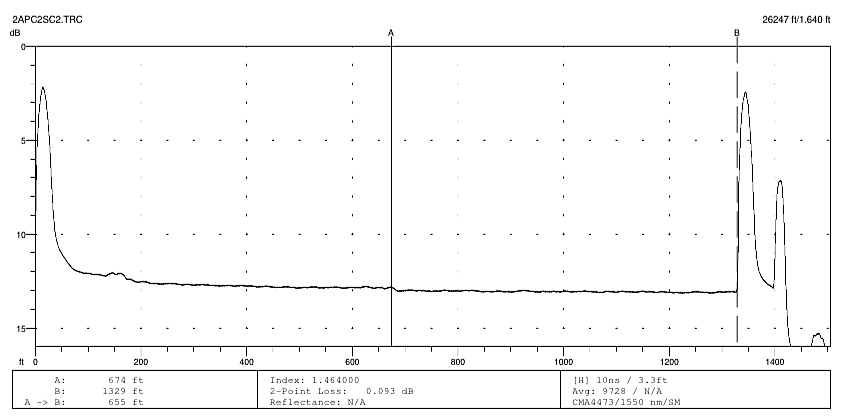
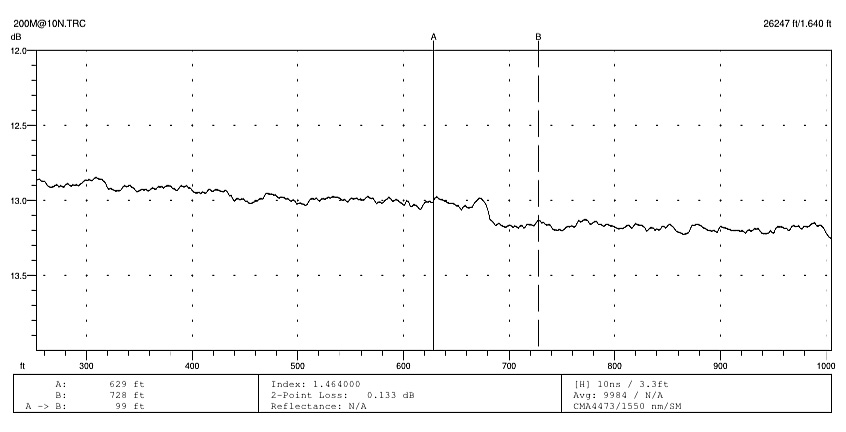
September 2022
Splicing Pigtails On A Cable
Q: I seem to be having an issue finding fiber protection sleeves
that can slide over the 3mm patch cable. I bought a sleeve that said it
with made for “single fiber fusion” but the thru hole which I would
side the cable thru prior to fusion is too small for the patch cable.
When I try and look on-line for specifications for the thru-hole size,
prior to fusion final melting of the glue in the sleeve, all I find are
post-melting diameters, none which are even close to being able to
handle the 3mm patch cable.
A: Splicing pigtails involves splicing the fibers only and the
cables are secured separately. The usual method of splicing on pigtails
is to splice the fibers and use the heat shrink tube to seal the splice
and the fibers from the outside air and protect it from stress. The
splice is placed in a splice tray. On either side, there is 2-3 feet of
fiber exposed from the cables being spliced. The splice tray has clamps
for all of the cables being spliced on the edges of the tray and the
fiber to the splice is coiled neatly on the splice tray. The jacket of
the pigtail is clamped at the edge of the splice tray but ends there,
so only fiber is coiled in the tray. If you try to coil fiber, the bulk
of the cable can get to be a problem where it’s coiled with the bare
fiber. You can get heat shrink protectors for fibers of 250 to 900 micron diameter buffers, but not for jacketed cables.
Important Questions From The Past
Managing And Maintaining a Fiber Optic Cable Plant During Its Lifetime.
Q: Are there guides / recommendations for optic fibre cable
life cycle management? (outside plant) including rehabilitation /
replacement timelines together with factors that may alter those
timelines ( such as seismic activity, extreme weather, human
activity-induced fibre cuts etc) also including typical performance
deterioration over the life cycle, and the performance levels at which
replacement / rehabilitation happens. Or does it happen (and is it
normally expected) that operators replace entire sections of fibre (say
400 km) as part of routine maintenance?
A: There is a saying here in the US that in fiber optics “the most common cause of failure is “backhoe fade” in underground cables
and “target practice” for aerial cables.” In other words, damage
caused by humans. We know of many fiber optic cable plants that have
survived natural disasters like earthquakes - in fact there is a lot of
work today using regular cables used in communications to monitor for
seismic activity. Fire can be a problem in remote areas, but often it’s
because the poles are burned causing the cables to fall.
Over the years we have questioned cable manufacturers about the lifetime
of fiber optic cable. They don’t like to make definitive statements but
we have been told that based on the cables installed in the past that
40 years is a probable lifetime for most cables. There are certainly
cables in use today that are over 30 years old already. The glass fiber
is not a problem, it’s the protection from the cables that will
eventually fail. Installation techniques can have an effect on the
longevity. For example splice closures should be sealed properly to
prevent ingress of moisture or dirt. Cables should not be installed with
bends below the rated bend radius or with excess tension.
FOA has always told users that fiber optic cables do not need maintenance (https://foa.org/tech/ref/user/maintain.html),
a response to some people advocating periodic inspection and cleaning
of connections, for example. That’s just more likely to cause damage.
When an accidental break in a cable occurs, we have guidelines for restoration (https://foa.org/tech/ref/restoration/rest.html), and planning for restoration when building the cable plant is very important.
Someday you will certainly want to replace cables, often well before the
lifetime of the cable, but generally because you need more fiber or the
older fiber will not support the network speeds you want for upgrades.
Planning for more fiber by installing more cables can be eased by
installing spare underground ducts when first installing cables - here
in the US, we call this “Dig Once” (https://foa.org/tech/ref/OSP_Construction/Underground_Construction.html). Testing fibers for higher speeds is called "fiber Characterization” (https://foa.org/tech/ref/testing/test/CD_PMD.html) and is routinely done when speeds above 10G or certainly 100G are considered for older fibers.
Knowing that the lifetime of fiber optic cable plants are ~40
years, it makes sense to plan ahead for future applications, installing
lots of fibers, leaving lots of open duct space and choosing network
architectures that will not obstruct upgrades. See the article on
Netly's network above.
Fiber Optic Color Codes Reference Chart
Q: Has anyone made a fiber optic pocket reference chart that has cable
color orders, frequencies, or other commonly used info on it?
A: The FOA has a page on its Online Guide that covers color codes
(https://foa.org/tech/ColCodes.htm). It is the most popular page in the
FOA Guide! It works great with a smartphone.

The
word on the "Dig Once" program is getting out - FOA
is getting calls from cities asking us for
information and advice. Here are some links:
The DoT page on the administration’s Executive
Order: http://www.fhwa.dot.gov/policy/otps/exeorder.cfm
And the
one to download and hand out:
A “How To” Guide from The Global Connect Initiative:
https://share.america.gov/wp-content/uploads/2016/04/6.-GCI-Dig-Once.pdf
Is There A Standard
For Fiber Optic Installation?
Another
question we get often is "Is there a standard for
fiber optic installation." The answer is yes, but
not from the usual standards groups you might
expect. Over 20 years ago, the National Electrical
Contractors Association (NECA) asked FOA to help
create a standard for installation. That standard,
ANSI/NECA/FOA-301 has been updated three times
already and is about ready for another update.
Unlike most of those groups who charge you a fortune
for standards, FOA covers the cost so ANSI/NECA/FOA-301
is available free from FOA.
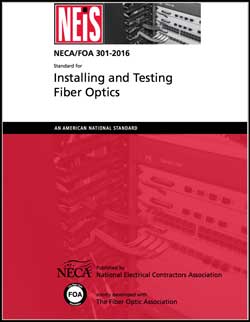
Download your free copy of ANSI/NECA/FOA-301
here (PDF)
Older
questions are now available here.
|
Training / FiberU
News and resources to help you learn more and stay
updated.
Find a
listing of all the FOA-Approved schools here.

Free online
self-study programs on many fiber optics and
cabling topics are available at Fiber U, FOA's
online web-based training website.
Free online training at
Fiber U
The FOA has >100
videos on  |
FOA School News
FOA's roster of approved schools is growing as more organizations
recognize our expertise in workforce development and our comprehensive
support for getting new schools started. FOA has over 25 years
experience and nearly 90,000 certified fiber techs (with ~120,000
certifications). As a non-profit organization founded by the industry
specifically to develop a competent workforce, FOA provides the
consultation, curriculum and contacts to get schools started as a free
service to new schools.
Welcome #5 in Ohio
This month FOA welcomes Washington County Career Center as our 5th
school in Ohio. Last year, the Governor's office held a formal ceremony
to announce the opening of a FOA school at Tri-County Career Center (FOA Newsletter September 2021.)
Washington County Career Center is the latest addition to the network
and two more are coming shortly. Soon Ohio will catch up with Kentucky
with 9 KCTCS schools in the FOA network.
Telecom Fiji
Andy Edwards of CommsLearning Limited emailed us as he was preparing to
head home to New Zealand that he had just spent time training personnel
at Telecom Fiji - 55 CFOT’s trained, 6 Designers and 4 instructors who
can deliver CFOT
internally with certifications going via
CommsLearning. Details above.
FOA Network Of
Approved Schools Continues To Grow
The
need for more fiber optic networks to support
fiber broadband and wireless/5G networks has led to a
strong demand for more trained and FOA-certified
techs, and that has led to a demand for more
training organizations. FOA has been adding new
schools and certifying new instructors to meet the
demand.
Schools added
recently:
School 775 INCITEL-UNI Lima Peru
School 406 Fiber Cert Santa Barbara, CA
School 404 Artison Technical Services, Waldorf, MD
School 403: Washington County Career Center
School 774: Arrow For Engineering, Amman, Jordan
School #401: Western Wyoming Community CollegeSchool 399: Team Fishel, Virginia
School 398, Telecom Tech, Colorado
School 396 Optconn, Boston, MA
School 395 Fiber Wizards
(Knowledge on Demand LLC)
School 393,
Carolina's Solution Group
School 394,
Tri-County Career Center, Nelsonville, Ohio
School
388: Global Com of Sterling, Virginia, USA
School 389. CWA-JATC Telecom Training Center, San
Jose, CA
School 390 Northern Allied Communications,
Nespelem, WA
School 391 Lewis-Clark State College,
Lewiston, ID
School 392 Wallace Community College, Dothan,
AL
Complete listing of FOA Approved Training Organizations
Need A Fiber Optic Course Onsite? Invite an FOA School To Come To You
FOA often gets inquiries from an organization that
has personnel that needs training in fiber optics. Recent inquiries have
included contractors, a manufacturer of high-reliability products using
fiber optics and a cable manufacturer. In many cases, where there are
several people needing training, FOA can recommend a FOA Approved School
and Certified Instructor who will come to their location to teach a
class. The advantage is of course the savings in travel costs if
the class comes to you, but it also offers the opportunity to customize
the course to fit your needs, even use your equipment or work on your
components, so the training is more relevant to those taking the class.
Contact FOA to discuss the idea of a custom, on-site class to see if it will better meet your needs.
FOA/Fiber U
On-The-Job Training (OJT) Program
The
FOA Fiber U OJT program for novices combines online study at
Fiber U with OJT with mentoring by experienced
co-workers and their supervisor to help new employees
develop into FOA-certified technicians in only
one year.
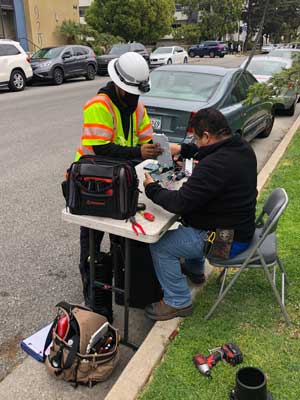
The FOA Fiber U “OJT-To-Cert”
program includes both fiber optics
and premises cabling (copper, fiber & wireless),
so it covers techs working in both outside plant and
premises jobs.
Like other FOA
programs, the OJT-To-Cert program is free. If you
and/or your company is interested in the FOA
OJT-To-Cert program,
contact FOA.
To explain how OJT
works and FOA's OJT-To-Cert program, FOA created a
short video: Lecture 62: On
The Job Training For Fiber Optics Using Fiber
U
FOA
Direct Certification Program For Experienced Fiber Optic Techs
Experience Plus
Online Study At Fiber U = FOA Certification
Experienced fiber optic technicians can become FOA Certified using
their experience in fiber optics and study for the
FOA certification exams online at Fiber U. Thousands of
industry professionals have applied to the FOA
directly for certification without the need for
classroom training, based on their knowledge and
skills developed working the field. Since FOA
certifications are based on KSAs (knowledge, skills
and abilities), current techs can show the
skills and abilities required through their field
experience. FOA provides free online self-study courses at Fiber U for the knowledge
part to prepare you for FOA certification exams
which you can also take online.
If you are an experienced field tech interested in
certification, and FOA is the internationally
recognized certifying body for fiber optics, you can
find out more about the FOA Direct Certification Program
here.
If you are already a CFOT, FOA also offers many
specialist certifications you can obtain based on
your experience as a field tech. See what's
available at Fiber
U.

Fiber U "Basic Fiber
Optics" Online Self-Study Course Now In Spanish
El curso de
autoaprendizaje en línea "Fibra óptica básica" de
Fiber U ahora en español
El sitio de
aprendizaje en línea de FOA, Fiber U, tiene más de
dos docenas de cursos de autoaprendizaje gratuitos
sobre fibra óptica y cableado de instalaciones.
Como era de esperar, el tema más popular es el
curso "Fibra óptica básica", que se utiliza para
iniciarse en la fibra óptica y como curso de
preparación para realizar el examen de
certificación FOA CFOT.
Ahora el curso básico
de fibra óptica está disponible en español,
utilizando el libro de texto FOA en español, la
sección de la Guía en línea en español y la
capacidad de YouTube para traducir subtítulos de
video al español. El curso funciona exactamente
como la versión en inglés con 10 lecciones, cada
una con cuestionarios y una opción para tomar un
examen de Certificado de finalización.
Para presentar el nuevo curso de
español Fiber U, el examen Certificate of
Completion es gratuito, así que dígaselo a sus
contactos.
Curso Básico de Fibra Óptica
de Fibra U en español.
New Fiber U Course: Fiber Characterization
FOA has added a new course at Fiber U on Fiber Characterization. Fiber
characterization is the process for testing long fiber cable plants for
its ability for carrying high speed communications. With so many
networks now operating at 100, 200, 400 or even 800 Gb/s, fiber
characterization is important, especially on older fiber optic cable
plants.The free Fiber U Fiber Characterization course is available in two forms, as a standalone Fiber U fiber Characterization Course with its own Fiber U Certificate of Completion and as a separate Lesson in the Fiber U Fiber Optic Testing course. This course is recommended for those studying for the FOA CFOS/FC Fiber Characterization certification.
Fiber U MiniCourses: Got An Hour Or Less?
Learn Something New About Fiber Optics.
FOA
has introduced a new type of Fiber U
course, the MiniCourse, a free online course you
could take in a short time, perhaps as you ate lunch
at your desk or took a coffee break. The
topics of these courses should explain what they are
about, and these are all very important topics to
fiber optic techs.
Fiber Optics In Communications
How Optical Fiber Works
Fiber Optic Network
Restoration
Fiber
Optic Connector Identification
Fiber U Color Codes
The Mysterious
dB of Fiber Optics
Fiber Optic Cable Bend Radius
Fiber Optic Link Loss And Power
Budgets
Fiber Optic Connector
Inspection And Cleaning
Fiber Optic Media Conversion
Fiber Optic Cable Midspan Access
Reading An OTDR Trace
Reference Cables For Testing
Fiber Optic Attenuators
The courses have two components, video lectures and
readings, that are complementary. As usual there is
a self-test to allow you to check your
comprehension. As with other Fiber U courses if you
desire, you can take a short test for a Fiber U
Certificate of Completion that costs
only $10.
All these free courses and many more
are available at Fiber U.
What Fiber Techs
Don't Know -
What We Learn From
FOA Certification Tests
As
FOA moves more testing over to our digital online
testing system at ClassMarker, we have access to
more data about our testing, including what
questions and topics on the tests are answered
incorrectly most often. Having this data gives us an
opportunity to evaluate the questions and how they
are stated, but more importantly it allow us to help
our instructors teach the subjects and us to change
our curriculum and online courses to emphasize these
particular topics. These are some of the topics that
we have noticed are answered incorrectly more often
in FOA and Fiber U tests.
Most of the questions missed are on testing.
1. OTDRs - particularly what information is in the
OTDR trace.
2. The difference between dB and dBm
3. Loss budgets - both the concepts and doing the
math
4. Insertion loss testing - single-ended or double
ended for testing patchcords or cable plants, how to
set 0dB references
5. Units of measure - fiber is measured in microns,
wavelengths in nanometers, etc.
At FOA, we're working to add Fiber
U MiniCourses on these topics and working with
our schools to emphasize these topics in their
classes.
If you are going to be taking a FOA certification
course or test in the near future, these topics
should be on your final exam study list.
What We Learn From Hands On Labs
We learn about students performance in hands-on labs
from the feedback of our instructors and our own
experiences too. One big problem is the use of hand
tools. Growing up today, you learn how to use
keyboards, mouses and touch screens, but decades
ago, you also learned how to use basic hand tools.
This is big enough of a problem that we're
considering adding some video lessons on basic hand
tools to prepare students for cable prep,
termination and splicing that require the use of
hand tools.
FOA Guide "Basics Of
Fiber Optics" Now Available Online in Portuguese
(6/2020)

FOA
has now translated the Basics of Fiber Optics
textbook in our Online Guide into Portuguese,
joining Spanish and French translations. For those
speaking Portuguese, we have the technical
information and for schools we also have curriculum
available.
Here is the FOA
Guide in Portuguese,
Spanish
and French
translations.
Time
To Learn - Online
Some
schools have been closed during the pandemic, so FOA
has been working with them to create new online
learning experiences that can in some cases lead to
certification online. FOA certifications are still
based on the KSAs - knowledge from the classroom,
skills from the labs and abilities judged by
instructors or proven by actual experience.
ZOOMing
Much of what we're doing benefits from the
capabilities of "Zoom." Others have created
videoconferencing apps, but none work so well,
especially with limited bandwidth. We've seen remote
labs that have an instructor showing students how to
use the tools they were sent then watching them
duplicate their actions. We have worked out methods
to use Zoom to proctor FOA's online certification
exams.
Blended
Learning
While most FOA schools have suspended in-person
training during this period, some are offering a
"blended learning" option. That means that
students sign up for a FOA certification course,
take the classroom sessions on Fiber U with the
assistance of a FOA certified instructor. Now
online instruction can include reviewing the
labs using the Fiber U Basic
Skills Labs, then when it's possible to attend
classes at the school, complete the hands-on
labs and take the FOA certification exam.
Online Remote Labs
Alternatively, some schools are experimenting
with "remote labs," where the students get
sent tool kits and components and labs are
conducted by videoconferencing. Before the
labs, the students may watch demos by their
instructor on videoconferencing and/or review
the relevant "virtual hands-on" lessons in the
Fiber U Fiber Optics Basic Skills Labs
so they will already know the steps in the
exercises. And Fiber U has
the new Fiber U
DIY Basic Skills Lab lesson
with directions on how to
purchase inexpensive tools
online and use them to learn
basic fiber optic skills. Videoconferencing
allows the instructor to remotely monitor
their work and provide help as needed. Contact
the FOA for more information.
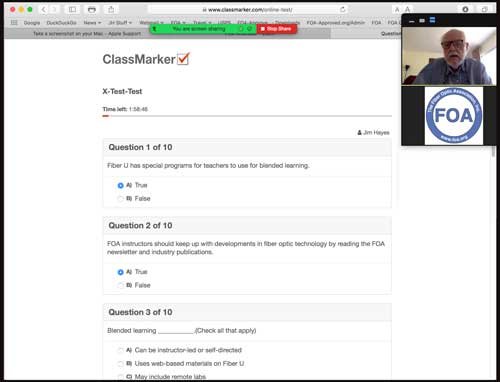
FOA Zoom Exam Proctoring
Online
Certification Testing
FOA has all its certification tests
available online, both for use by our
schools and by our direct "Work
to Cert" applicants. All FOA
certification tests require a proctor to
oversee the applicant taking the exam. In
this time of social distancing, getting a
proctor can be difficult, so FOA now has
procedures for online proctors
administering the exam. Contact
the FOA for more information.
OJT - On-The-Job-Training
Many novices get a job and learn on the job.
They usually have an experienced tech who helps
them gain the knowledge and learn the
skills they need to perform their job. Thinking
about this in relation to the FOA KSAs,
the knowledge, skills and abilities needed by a
fiber optic tech, the tech will learn
skills but not the basic knowledge that helps
them understand the processes involved. FOA can
offer help here with our FOA's
OJT-to-Cert Program,
using our Fiber
U online self-study programs. While the
tech learns on the job, they become a Fiber
U trainee, getting the knowledge they
need, while working under their "mentor" at
work. This is particularly good for
contracting companies who need techs but do
not have the usual training courses
available. Interested in OJT programs? Click
on the link below or contact FOA for
more information.
FOA's OJT-to-Cert
Program

FOA offers free online self-study programs at Fiber U.
Many users are preparing for FOA certification
programs - taking courses at our schools or using
the "Work-to-Cert" program. Some of our
schools are requiring Fiber U programs as
prerequisites for their classroom courses so they
can spend more time on hands-on activities.
FOA School Offers
Toolkit With Online Training
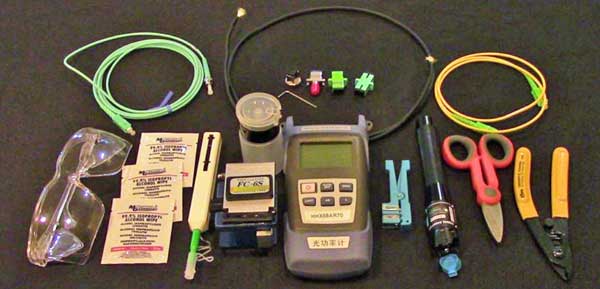
Slayton Solutions
(FOA Approved School #156) is offering a simple
fiber optic tool kit that includes a 29-piece set
of fiber optic tools and a power meter along with
training videos and online instruction for only
$499. 29 Piece Kit includes all tools and devices
a technician needs to install fiber optic
connectors and test optical power. You can contact them for
more information at slaytonsolutions@sbcglobal.net
or https://www.fiberopticsinstitute.com
|
Publications /
Resources

|
Cross Reference To FOA Tech Materials
FOA has so much technical reference material, we created a cross reference guide to the textbooks,
Online Guide and Fiber U courses, all the FOA technical information.
Besides the textbooks, online Guide and Fiber U, each section of the
Guide also includes links to the 100+ FOA videos available.
Cross Reference Guide to Textbooks, Online Guide and Fiber U
FOA Guide To Fiber Optic Workforce Development
To help those new to fiber optic workforce development, FOA has created a web page we call "Fiber Optic Workforce Development."
In this page, we share what we have learned about the fiber optic
workforce, who they are and how they learn their trade. We discuss what
defines a fiber optic tech and how they should be certified.
Read the FOA Guide To Fiber Optic Workforce Development online.
Latest FOA Book: Fiber Broadband (Paperback and Kindle)
 In less than half a century,
fiber optics has revolutionized communications and to a large extent,
society in general. Broadband, what many today call high speed Internet
access, has become a necessity for everyone, not a luxury. The
technology that makes broadband possible is fiber optics, connecting the
continents, cities, and just about everybody. Even fiber to the home
(FTTH) brings broadband to hundreds of millions worldwide. In less than half a century,
fiber optics has revolutionized communications and to a large extent,
society in general. Broadband, what many today call high speed Internet
access, has become a necessity for everyone, not a luxury. The
technology that makes broadband possible is fiber optics, connecting the
continents, cities, and just about everybody. Even fiber to the home
(FTTH) brings broadband to hundreds of millions worldwide.
How did we get from an era when communications was making a telephone
call or sending a telegram to today’s world where every piece of
information – and misinformation – is available at the click of a mouse
or touch on a screen? How did we get from a time when a phone was
connected on copper wires to being able to connect practically anywhere
on a handheld device with more computing power than was available to
scientists and engineers only decades ago?
How does broadband work? Without fiber optics it would not work.
This book is not the typical FOA technical textbook - it is written for
anyone who wants to understand fiber broadband or fiber optics or the
Internet. It's also aimed at STEM teachers who want to include
communications technology in their classes. This book will try to
explain not only how fiber broadband works, but how
it was developed. It is intended to be an introduction to
communications technology
appropriate for a communications course at almost any level (junior
high, high school or
college,) for managers involved with broadband projects, or for anyone
who just wonders how all this stuff works.
The Fiber Optic Association Guide To Fiber Broadband
Paperback ($12.95) and Kindle ($9.95) versions available from Amazon or most booksellers. Kindle version is in color!
More Translations of FOA Textbooks
 FOA is a very international organization and it works hard to
accommodate the language needs of everyone. We have been translating our
books and website into the languages most requested, and this month, we
add two more textbook translations. We also want to thank Jerry Morla,
FOA CFOS/I instructor and Director who has been doing the recent
translations into Spanish, his native language. FOA is a very international organization and it works hard to
accommodate the language needs of everyone. We have been translating our
books and website into the languages most requested, and this month, we
add two more textbook translations. We also want to thank Jerry Morla,
FOA CFOS/I instructor and Director who has been doing the recent
translations into Spanish, his native language.
Here is a listing of all the FOA textbook Translations
Spanish Editions:
Guía de Referencia de la Asociación de Fibra Óptica (FOA) Sobre Fibra
Óptica: Guía de estudio para la certificación de la FOA Amazon
La Referencia de Cableado para Predios de la FOA: Guía para Certificación de la FOA Amazon
La Asociación de Fibra Óptica Manual de Fibra Hasta el Hogar : Para
Planificadores, Gestores, Diseñadores, Instaladores y Operadores De
FTTH Amazon
Guía de Referencia de la FOA sobre Diseño de la red de fibra óptica: Guía de Estudio para la Certificación de la FOA Amazon
And the FOA Reference Guide To Fiber Optics:
French Edition: Le
Guide de référence de la FOA pour la fibre optique et et
guide d'étude pour la certification FOA: Guide d'étude pour
la certification FOA Amazon
Portuguese Edition: Guia de Referência sobre Fibra Óptica da FOA : Guia de Estudo para a Certificação da FOA Amazon
The subject matter of these books is also translated in the FOA Guide online.
Planning A Fiber Optic Project?
The FOA Guide To Fiber Optic Projects includes this timeline and comments on project planning and implementation.
More New FOA Video
Lectures On YouTube
Did you know YouTube
will close caption videos in many languages?
Here are directions.
FOA Lecture 73, The History of Fiber Optics - A Timeline fiber optics from the beginning.
FOA YouTube Video Describes
On-The-Job Training (OJT)
FOA Lecture 67 Fiber Optics At
Electrical Utilities
More New Videos
Including FTTH Series
Like all our YouTube lectures, they are
all short and easy to understand.
Did
you know YouTube will close caption videos in many
languages?
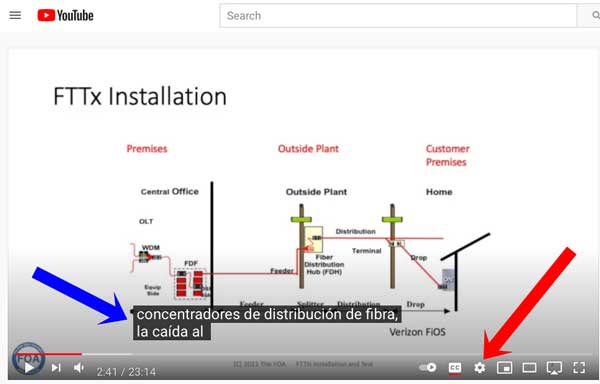
Sign in with Google to get translations for closed
captioning. Click on the settings icon (red arrow.)
Choose "Subtitles". English is the default
language. Click on the arrow after "English
(auto-generated) >". In the new window click on
"Auto-translate" and choose the language you
want.
FOA Loss Budget
Calculator On A Web Page 5/2020
FOA
has written many articles about loss budgets,
something everyone involved in fiber optics needs to
know and needs to know how to calculate. We recently
discovered how to get a spreadsheet ported to a Web
page, so we created this web page that calculates
loss budgets. We have an iOS loss budget app, but
with this web page, you can calculate loss budgets
from any device, smart phone, tablet, laptop, or
desktop computer that has web browsing capability.

Bookmark this page (especially on your
smartphone): FOA Loss Budget Calculator
Online
 We are continually updating the Online Reference
Guide to keep up with changes in the industry and
adding lots of new pages of technical information.
When you go to the FOA
Guide Table of Contents to see the latest
updates - look for
We are continually updating the Online Reference
Guide to keep up with changes in the industry and
adding lots of new pages of technical information.
When you go to the FOA
Guide Table of Contents to see the latest
updates - look for  . .
Recent updates:
FTTH
Updates: Added a section on FTTH Network Design,
updated Architecture and PONs (10G)
Color Codes For Fiber Optics
Includes print your own pocket guide and versions for your smartphone.
Fiber
Optic Projects - the FOA Guide to projects from
concept to operation
Coherent Communications Systems in
the FOA Guide.
Go
to The FOA Online Fiber Optic
Reference Guide.
FOA Reference Books
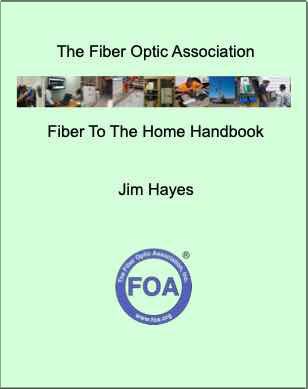
FOA's FTTH Handbook: We've
gathered all our information on FTTH from the FOA
Guide and past issues of the FOA Newsletter and
edited it into a 112 page "FTTH Handbook." We even
added a section on planning and managing FTTH
Projects.
The Fiber Optic Association
Fiber To The Home Handbook is
available from Amazon in print and Kindle
editions.
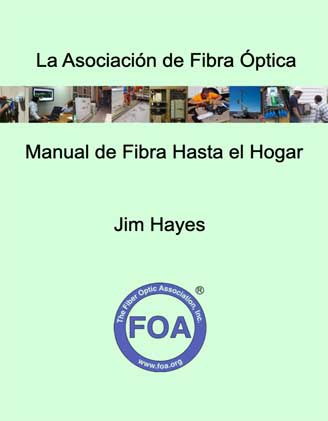
Sitio web y manual de FTTH ahora en español
Sitio web y manual de FTTH ahora en español - FTTH Website And Handbook Now In Spanish
El Manual FOA FTTH se ha convertido en el libro FOA
más vendido y tiene una calificación de 4.7/5 por parte de los
compradores en Amazon.
FOA ha notado mucho interés en FTTH en otras áreas del mundo,
especialmente en América Central y del Sur, por lo que tradujimos el
sitio web de FTTH y el Manual de FTTH al español.
Available in paperback from Amazon or ebook on Amazon Kindle.
Disponible como libro de tapa blanda en Amazon o como libro electrónico en Amazon Kindle.
El sitio web de FOA FTTH ahora en español.
El Manual FOA FTTH se ha convertido en el libro FOA
más vendido y tiene una calificación de 4.7/5 por parte de los
compradores en Amazon.
FOA ha notado mucho interés en FTTH en otras áreas del mundo,
especialmente en América Central y del Sur, por lo que tradujimos el
sitio web de FTTH y el Manual de FTTH al español.
Disponible como libro de tapa blanda en Amazon o como libro electrónico en Amazon Kindle.
El sitio web de FOA FTTH ahora en español.
 
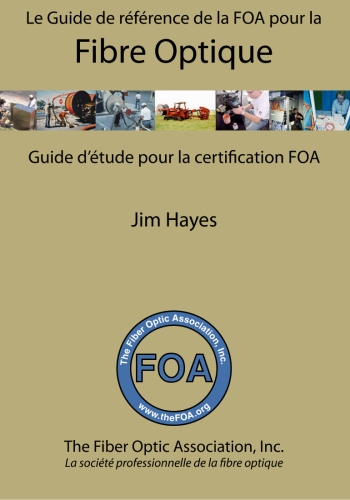      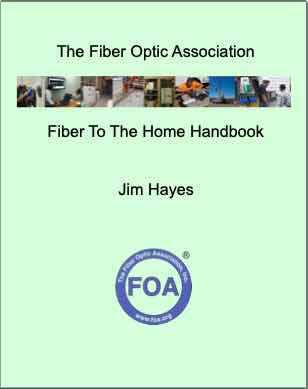
Fiber Optics (4 languages), Premises Cabling, OSP
fiber and construction, Network Design, Testing and
FTTH
The FOA has it's own
reference books for everyone working in fiber
optics - contractors, installers and end users as
well as for use as textbooks in classes at
educational institutions. They are available as
printed books or Kindle at much lower prices than
most textbooks since we self-publish and sell
online, cutting out the middlemen. Click on the
book images for more information. The Reference
Guide To Fiber Optics is also available in
Spanish, French and Portuguese. The Design book is available in English
and Spanish.
Click on any book for more information
about it.
FOA
has reprinted

"Lennie Lightwave's Guide"
on its 25th anniversary in a special print
edition.
Lennie
and Uncle Ted's
Guides are online or as free iBooks on iTunes.


Click on any of
the books to learn more.
- Fiber
Optic Safety Poster to download and
print
Resources For
Teachers In K-12 And Technical Schools
Teachers in all grades can introduce their
students to fiber optic technology with some
simple demonstrations. FOA has created a page for
STEM or STEAM (science, technology, engineering, arts
and math) teachers with materials appropriate to
their classes. Fiber Optic Resources For
Teachers.
|
Safety
|
On Safety
The FOA is concerned about safety!
FOA
considers safety an integral part of all our
programs, curriculum materials and technical
materials. We start all our textbooks and their
online versions with a section on safety in the
first chapter, like this: Before
we get started - Safety First!
There are pages on the FOA Guide on Safety
procedures Including Eye Safety and. Digging
Safely
And a YouTube lecture: FOA Lecture 2: Safety When Working
With Fiber Optics
In our OSP Construction Section, these pages cover
many safety issues including those related to the
construction of the cable plant: Project Preparation And Guidelines,
Underground Cable Construction,
Underground Cable Installation
and Aerial Cable Installation.
There is even a safety poster for the fiber
activities: PDF Safety Rules For Fiber Optics
Other Safety Resources:
There is a toll-free
"call before you dig" number in the USA: Dial 811. See www.call811.com
for more information in the US. Here is their map of resources by states.
In Canada, it's "Click Before You Dig.com" They also have a page of resources by US states and Canadian provinces.
The Common Ground
Alliance has an excellent "Best Practices Guide"
online
- The US Department
of Transportation has a website called "National
Pipeline Mapping System" that allows one
to search for buried pipelines.
Why We Warn You To
Be Careful About Fiber Shards
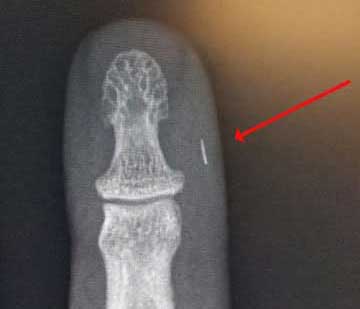
Photo courtesy Brian Brandstetter,
Mississauga Training Consultantcy
2023 Conference On
Damage Prevention In Tampa

Global Excavation Safety Conference Tampa, Florida
February 14-16, 2023
GlobalExcavationSafetyConference.com:

The magazine, dp-Pro, sponsor of the conference,
has also published it's latest issue with an
article by FOA on "New Construction Techniques
in Fiber Optics" and a overview of the FOA. You can read the magazine here.
When You Bury Marker
Tape, Bury One That Will Work (July 2021)
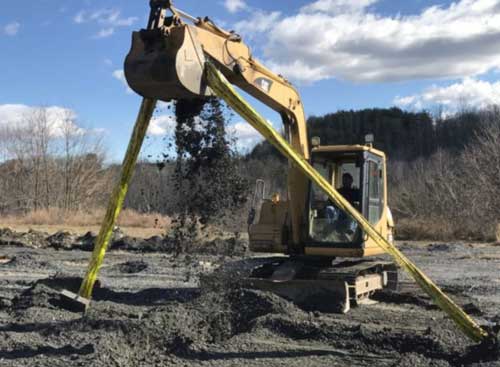
Signaltape® provides a visual
warning by ensuring tape is brought to the surface,
alerting the operator to the presence of a buried
utility. It includes a 3,000-lb. tensile strength
aramid fiber membrane, which ensures the tape is
pulled to the surface to alert the excavation crew.
Signaltape
comes in two sizes: 12″ x 1000′ or 6″ x
1000′.
FOA
Corporate Members - Products & Services
List
of corporate member information provided by FOA
corporate members listed on the FOA website.
|
FOA/About
About The FOA
- Contact
Us: http://www.foa.org
or email <info@foa.org>

FOA has a company page
and four LinkedIn Groups
FOA
- official company page on LinkedIn
FOA
- covers FOA, technology and jobs in the fiber optic
marketplace
FOA
Fiber Optic Training - open to all, covers
fiber optic technology and training topics
Grupo de La Asociación de
Fibra Óptica FOA (Español)
|
What is The FOA?
The FOA is a, international non-profit
educational association chartered to promote
professionalism in fiber optics through education,
certification and standards.
Founded in 1995 by a dozen prominent fiber optics
trainers and leaders from education, industry and government as a professional society for fiber
optics and a source of independent certification,
the FOA has grown to now being involved in numerous
activities to educate the world about fiber optics
and certify the workers who design, build and
operate the world's fiber optic networks.
Read More
FOA History
FOA Timeline of Fiber Optics
Contact
Us
The Fiber Optic Association Inc.
https://www.foa.org or email
<info@foa.org>
https://www.thefoa.org or email <info@thefoa.org>
Telephone/text: 760-451-3655
The
FOA Home Page

Want to know more about fiber optics? Study
for FOA certifications? Free
Self-Study Programs are on "Fiber U®."
Looking for specific information? Here's the largest
technical reference on the web: The
FOA Online Fiber Optic Reference Guide.

Free online self-study programs
on many fiber optics and cabling topics are
available at Fiber U,
FOA's online web-based training website.
|
-
Contact Us
The Fiber Optic Association Inc.
The FOA Home Page
Fiber Optic Timeline
(C)1999-2023, The Fiber Optic Association, Inc.
|
FOA Logo
Merchandise
New FOA Swag! Shirts,
Caps, Stickers, Cups, etc.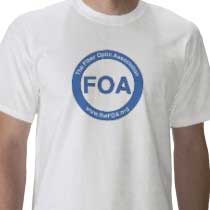
The
FOA has created a store on Zazzle.com offering lots
of new logo merchandise. It has lots of versions of
shirts and other merchandise with "FOA," "Fiber U,"
"Lennie Lightwave" designs and more so you should
find something just for you! See FOA on Zazzle.
-
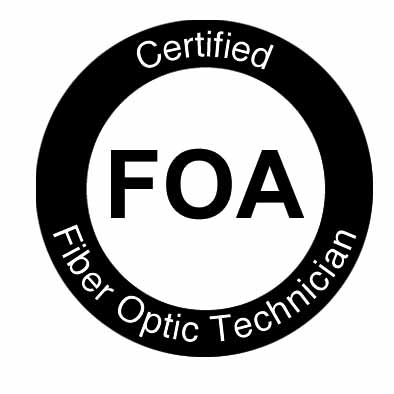
Your
Name, CFOT® - It pays to advertise!
The FOA encourages
CFOTs to use the logo on their business cards,
letterhead, truck or van, etc. and provides logo
files for that purpose. But we are also asked
about how to use the CFOT or CFOS certifications.
Easy, you can refer to yourself as "Your Name,
CFOT" or "Your Name, CFOS/T" for example.
Feel free to use the
logo and designations to promote your achievements
and professionalism!
Contact
FOA at info@thefoa.org to get logos in file format
for your use.
Privacy Policy (for
the EU GDPR): The FOA does not
use cookies or any other web tricks to gather
information on visitors to our website, nor do
we allow commercial advertising. Our website
hosts may gather traffic statistics for the
visitors to our website and our online testing
service, ClassMarker, maintains statistics of
test results. We do not release or misuse any
information on any of our members except we will
confirm FOA certifications and Fiber U
certificates of completion when requested by
appropriate persons such as employers or
personnel services.
Read
the complete FOA Privacy Policy here.
|



























 How does broadband work? Without fiber optics it would not work.
This book is not the typical FOA technical textbook - it is written for
anyone who wants to understand fiber broadband or fiber optics or the
Internet. It's also aimed at STEM teachers who want to include
communications technology in their classes. This book will try to
explain not only how fiber broadband works, but how
it was developed. It is intended to be an introduction to
communications technology
appropriate for a communications course at almost any level (junior
high, high school or
college,) for managers involved with broadband projects, or for anyone
who just wonders how all this stuff works.
How does broadband work? Without fiber optics it would not work.
This book is not the typical FOA technical textbook - it is written for
anyone who wants to understand fiber broadband or fiber optics or the
Internet. It's also aimed at STEM teachers who want to include
communications technology in their classes. This book will try to
explain not only how fiber broadband works, but how
it was developed. It is intended to be an introduction to
communications technology
appropriate for a communications course at almost any level (junior
high, high school or
college,) for managers involved with broadband projects, or for anyone
who just wonders how all this stuff works..jpg) Managing
a fiber optic project can be the easiest part of the installation if
the design and planning have been done thoroughly and properly, or, if
not, it can be the the hardest. It's certainly important to understand
what managing a project entails.
This new Fiber U MiniCourse starts by defining a fiber optic project
then explains what's involved in managing it from concept to operation.
Managing
a fiber optic project can be the easiest part of the installation if
the design and planning have been done thoroughly and properly, or, if
not, it can be the the hardest. It's certainly important to understand
what managing a project entails.
This new Fiber U MiniCourse starts by defining a fiber optic project
then explains what's involved in managing it from concept to operation.



















 OptConn
is a value-add re-seller of optical connectivity products, services and
solutions. With over 30 years of experience in the fiber optics
industry we are here to serve your requirements from fiber optic
training with FOA certification to products, materials and supplies.
OptConn
is a value-add re-seller of optical connectivity products, services and
solutions. With over 30 years of experience in the fiber optics
industry we are here to serve your requirements from fiber optic
training with FOA certification to products, materials and supplies. 


























 .
.







